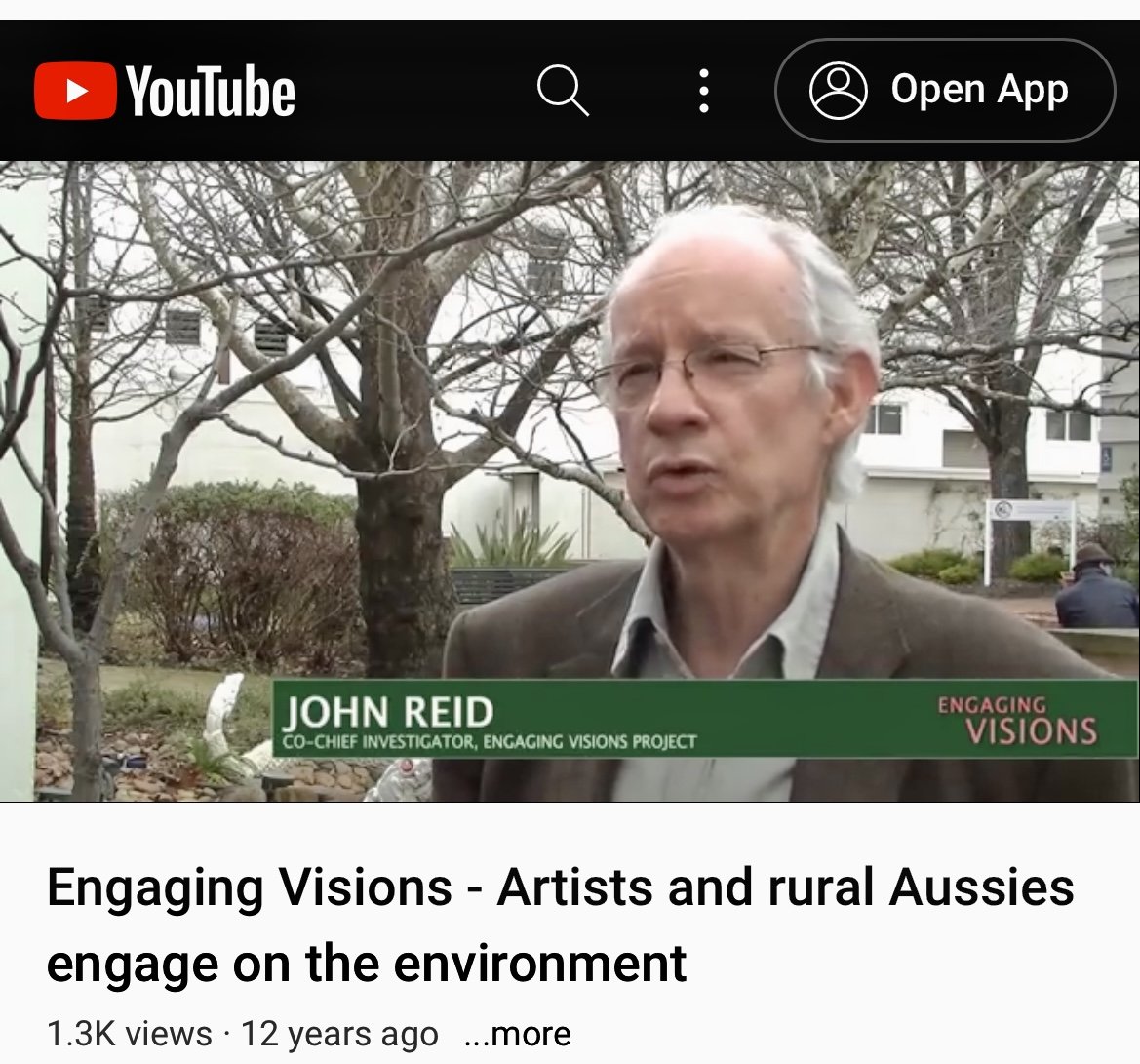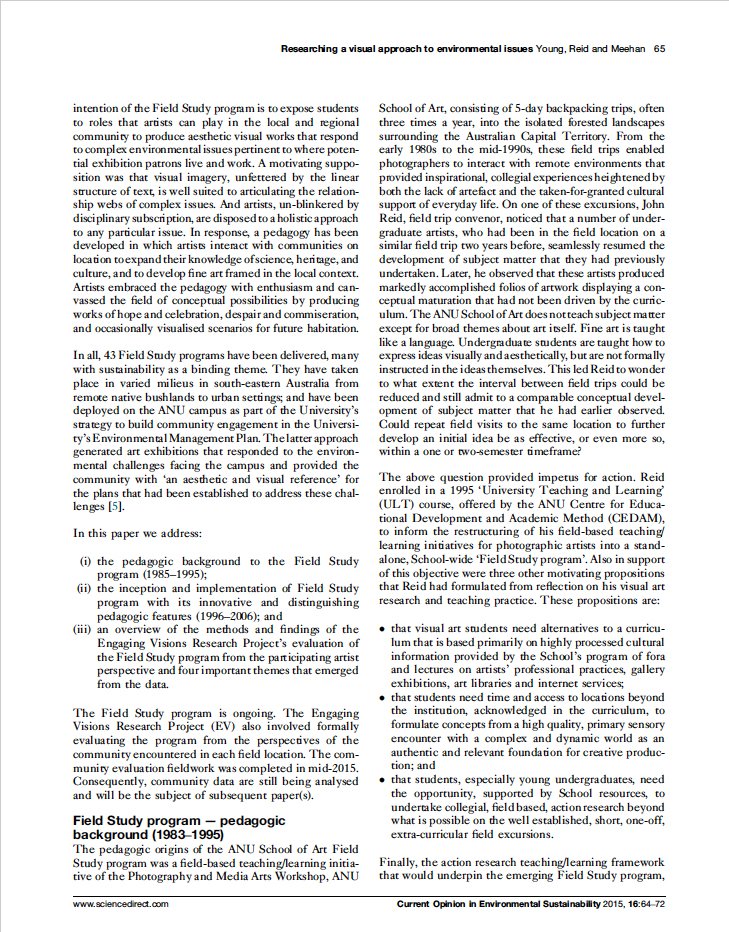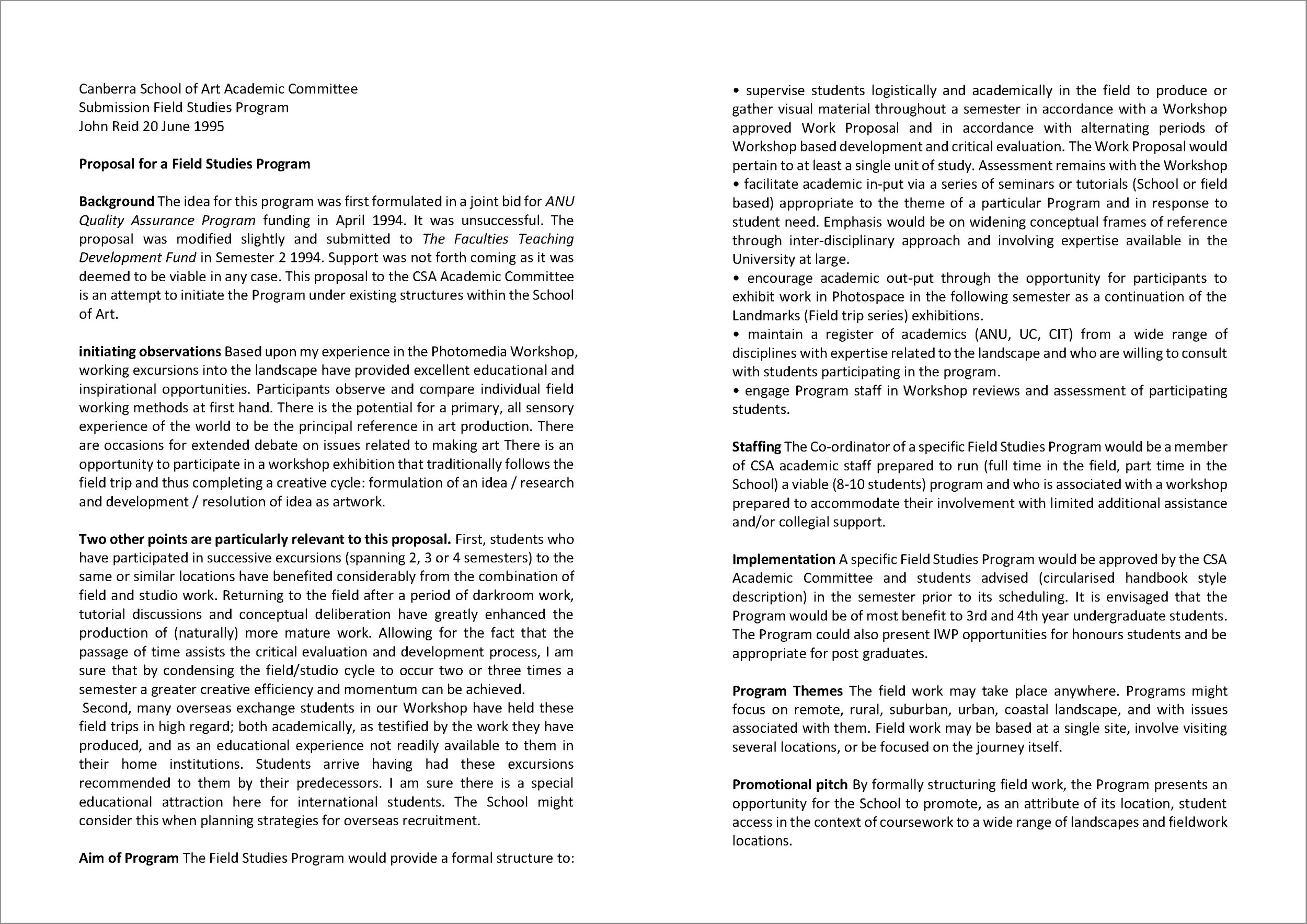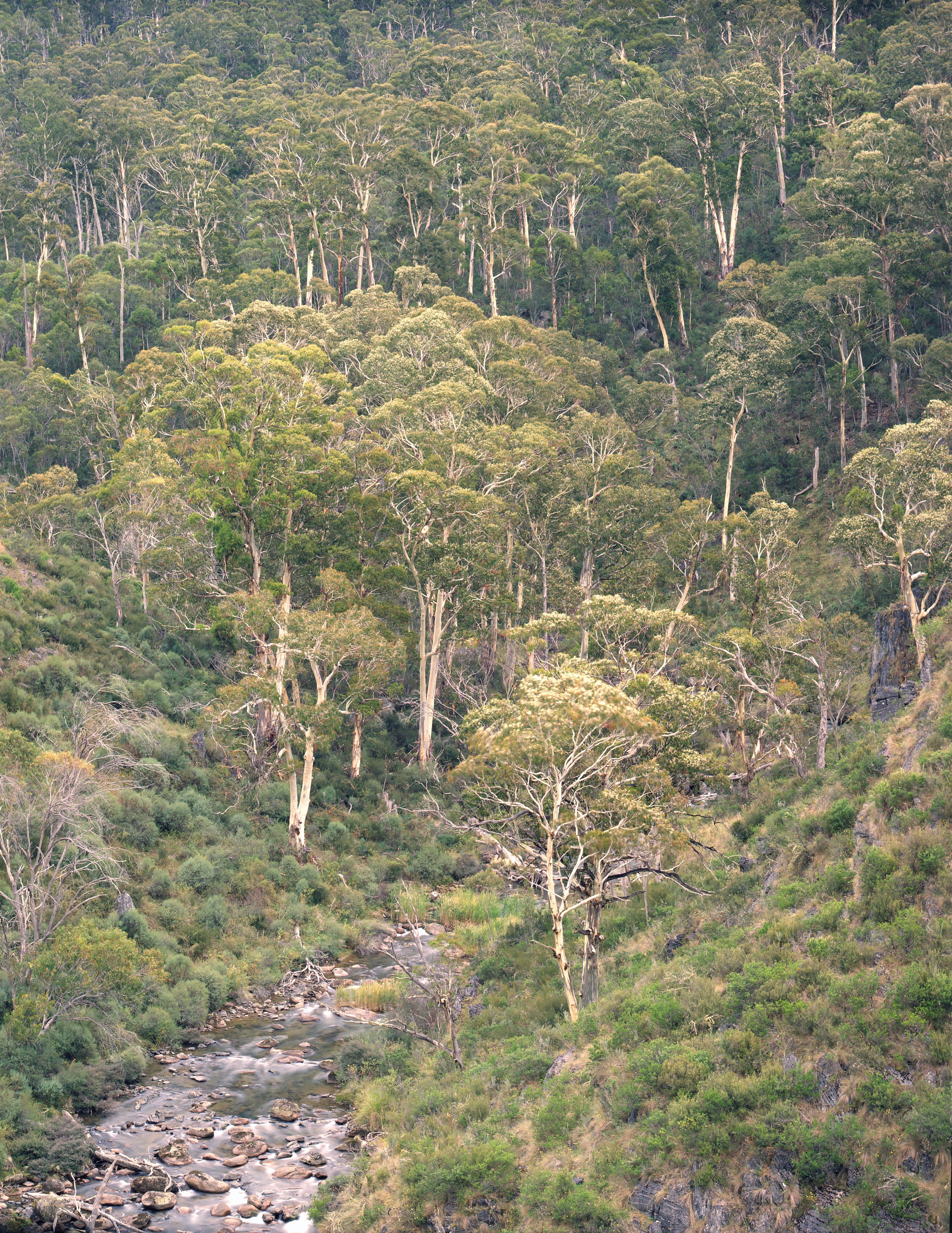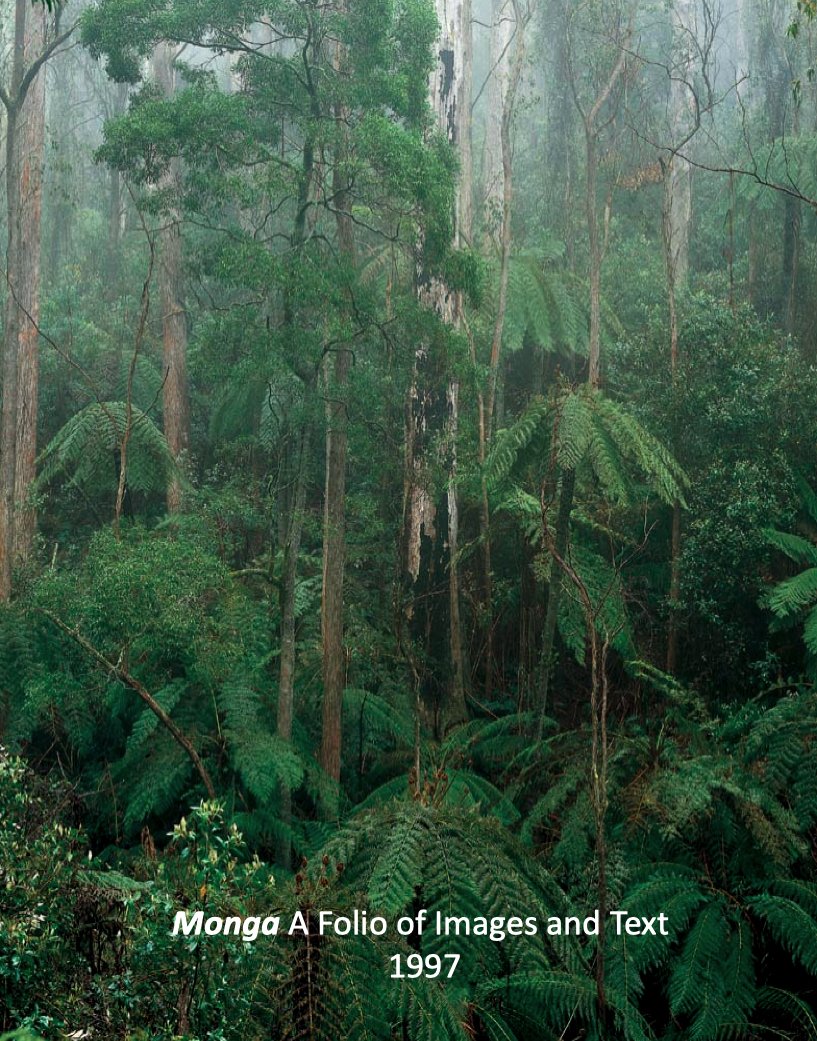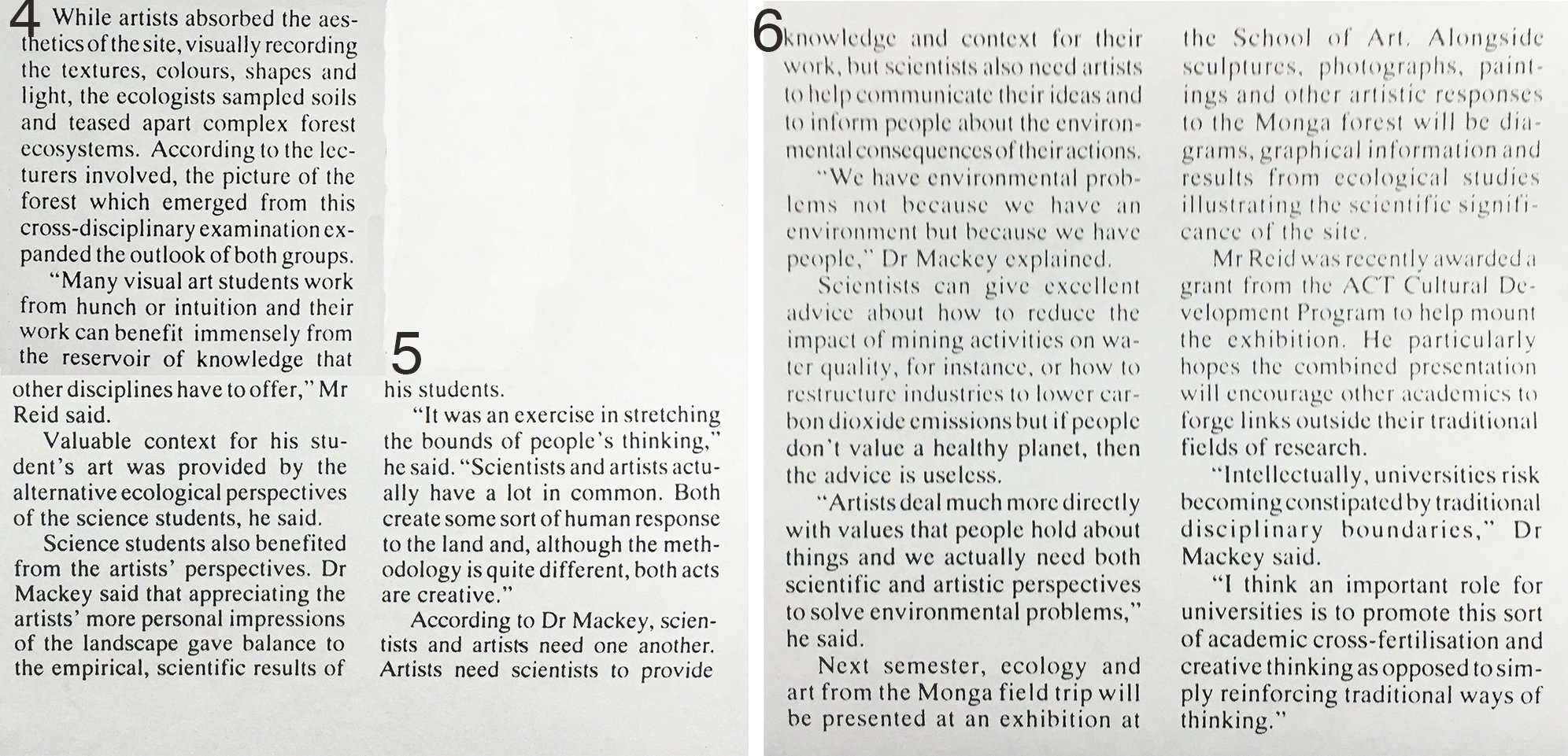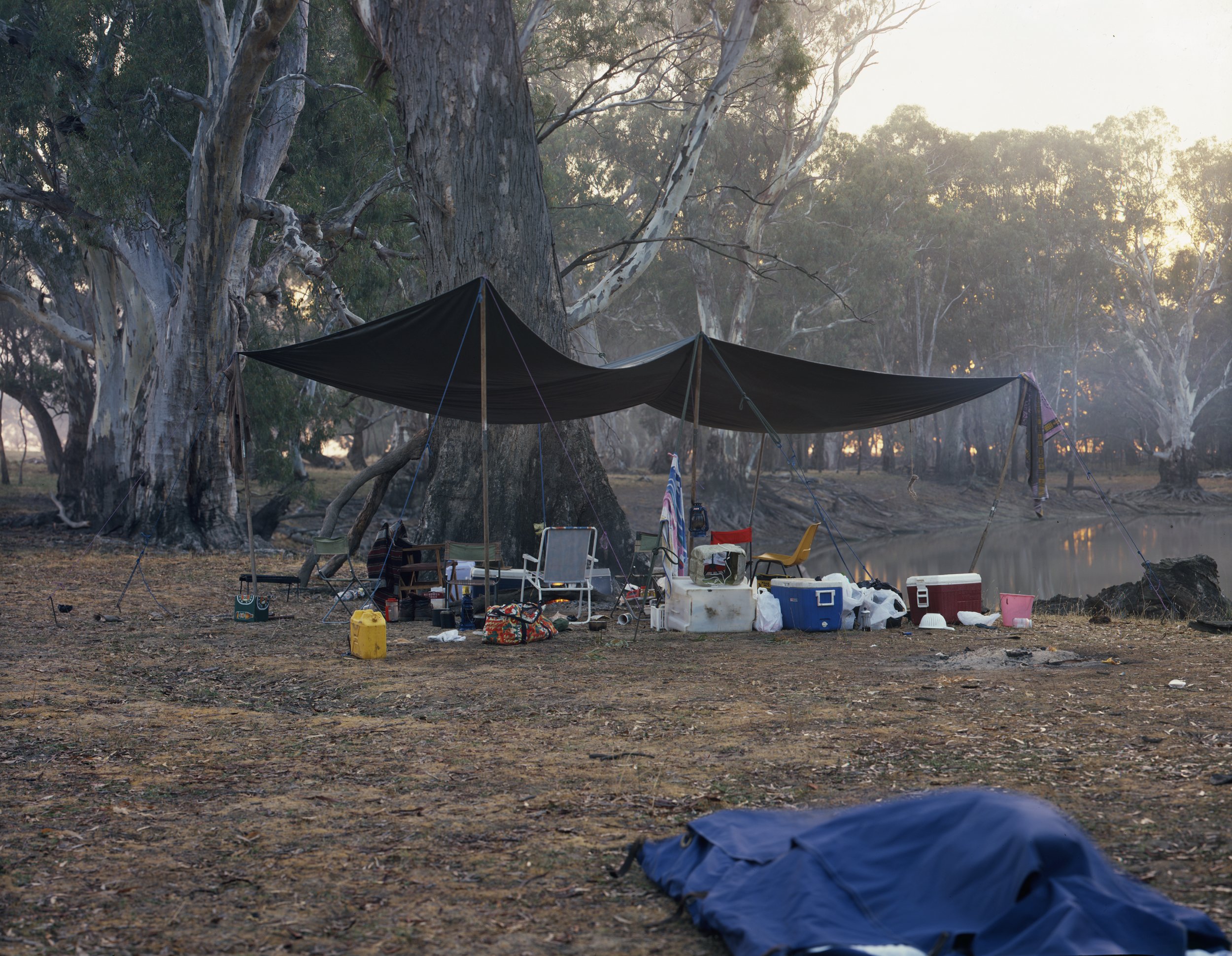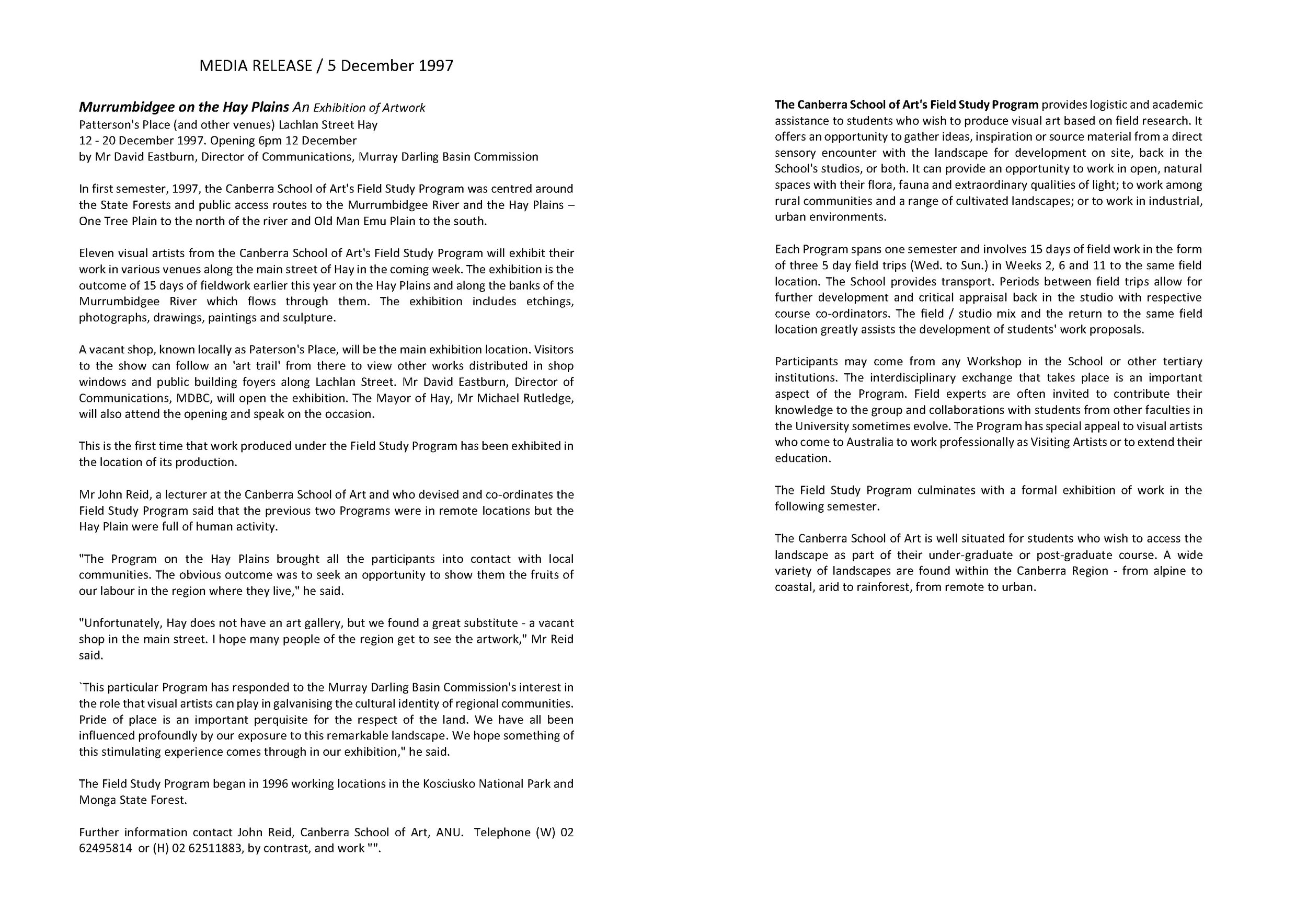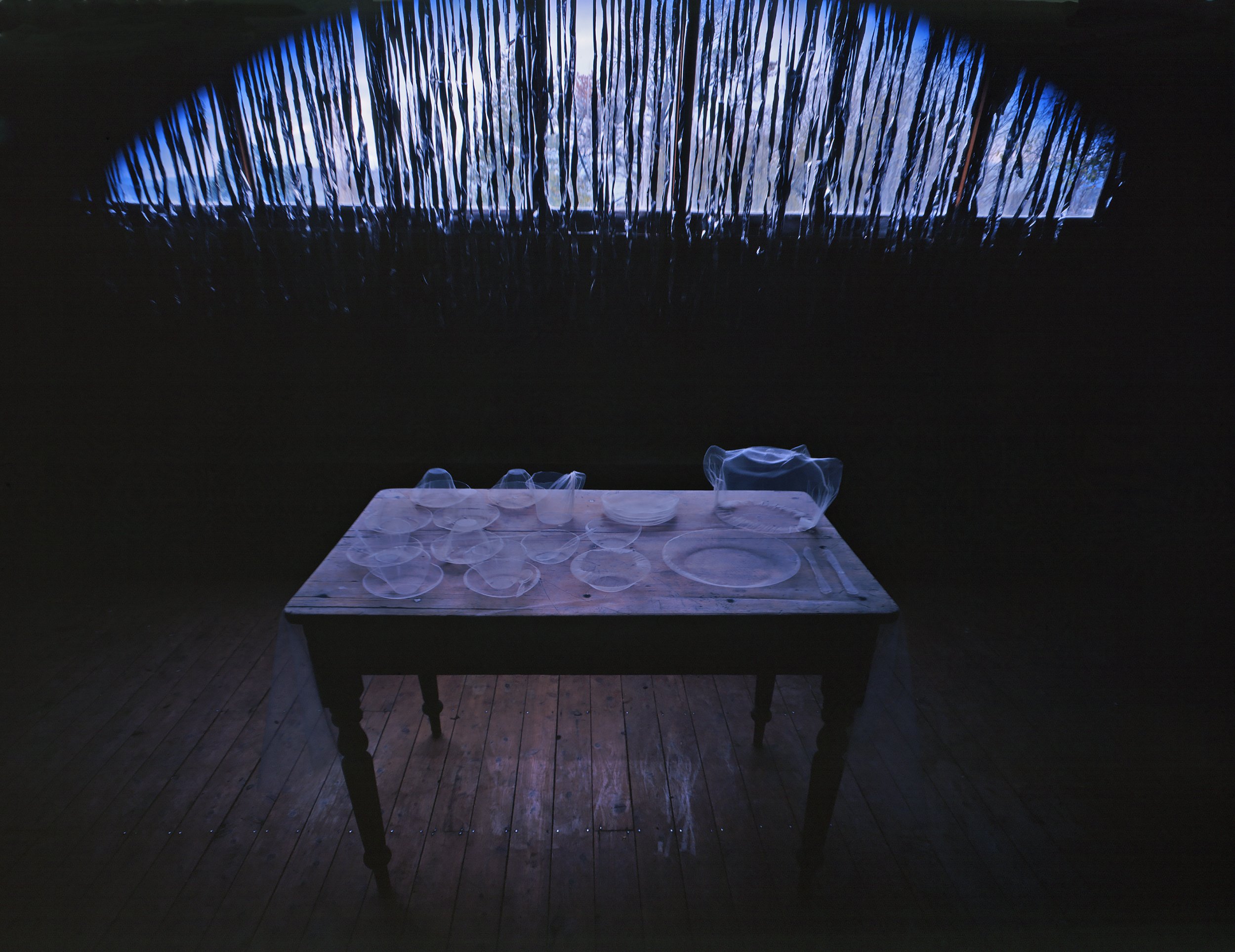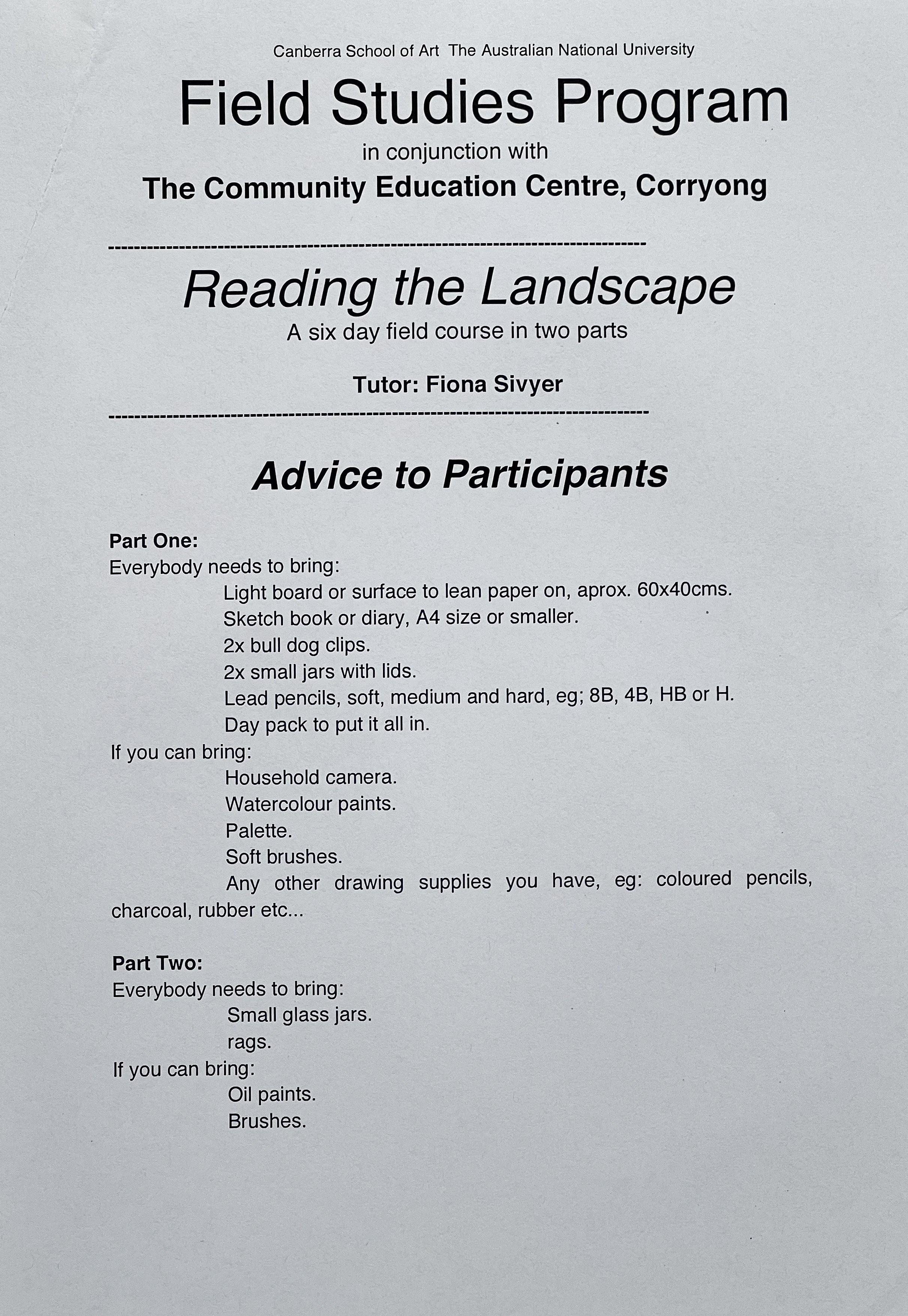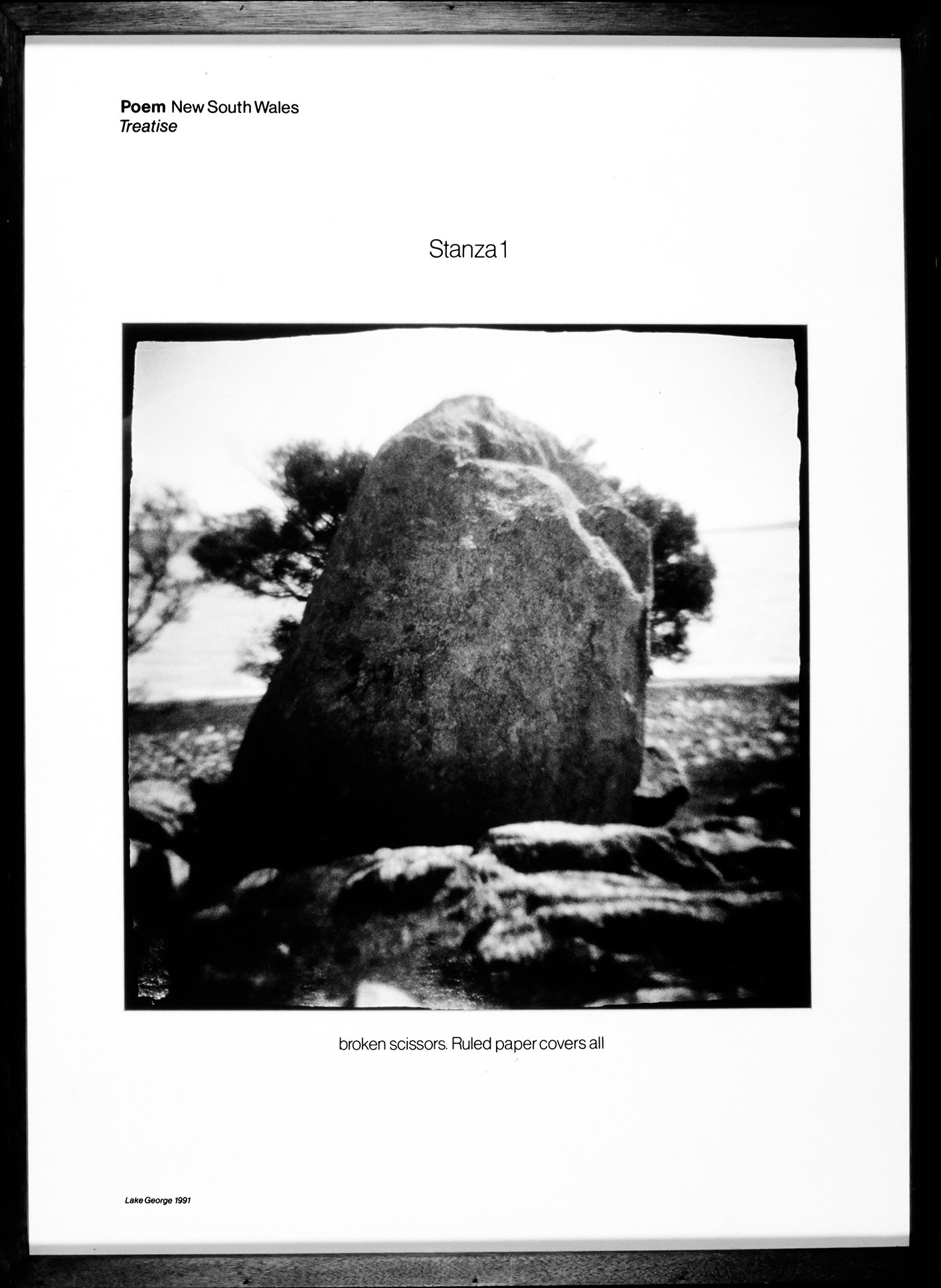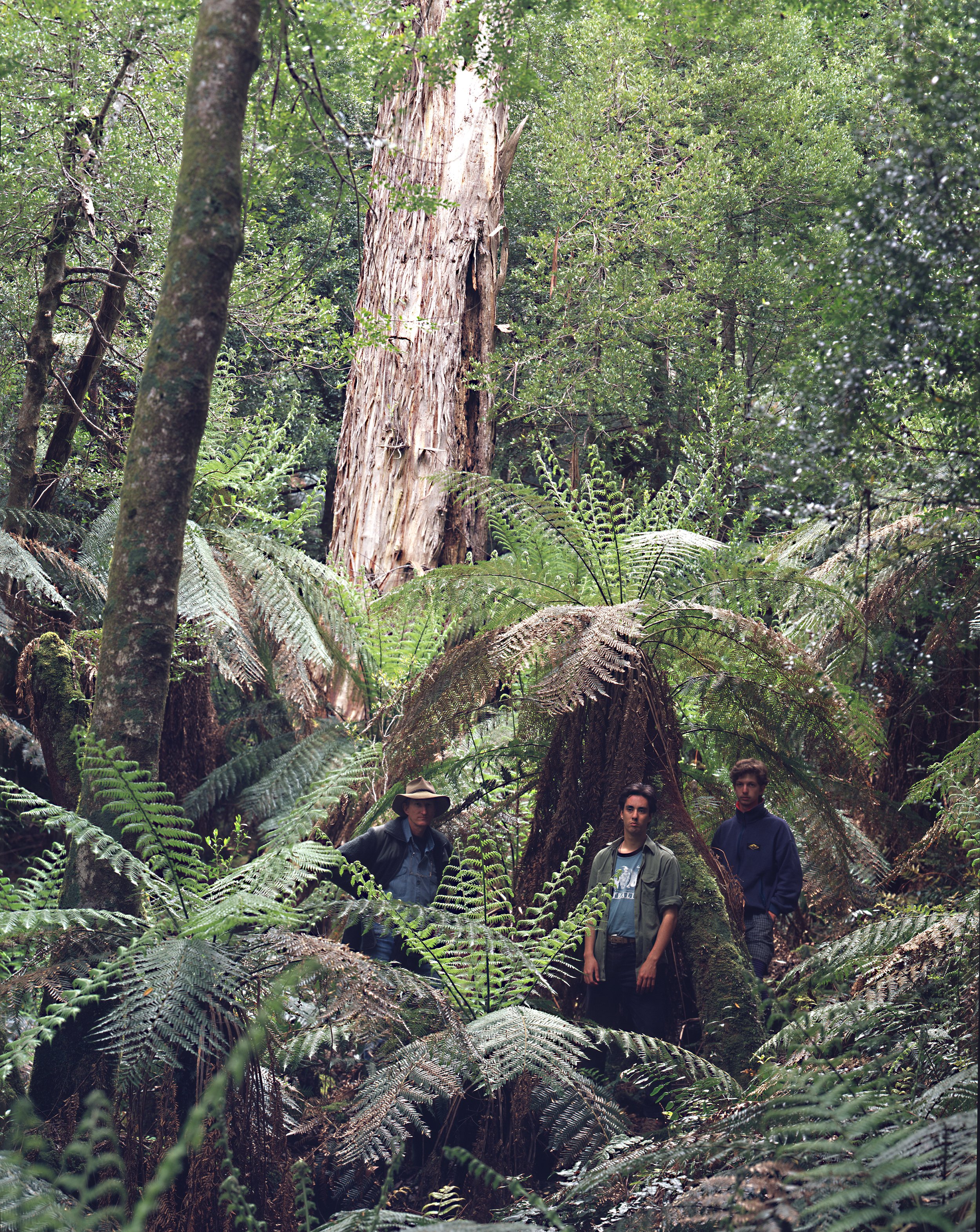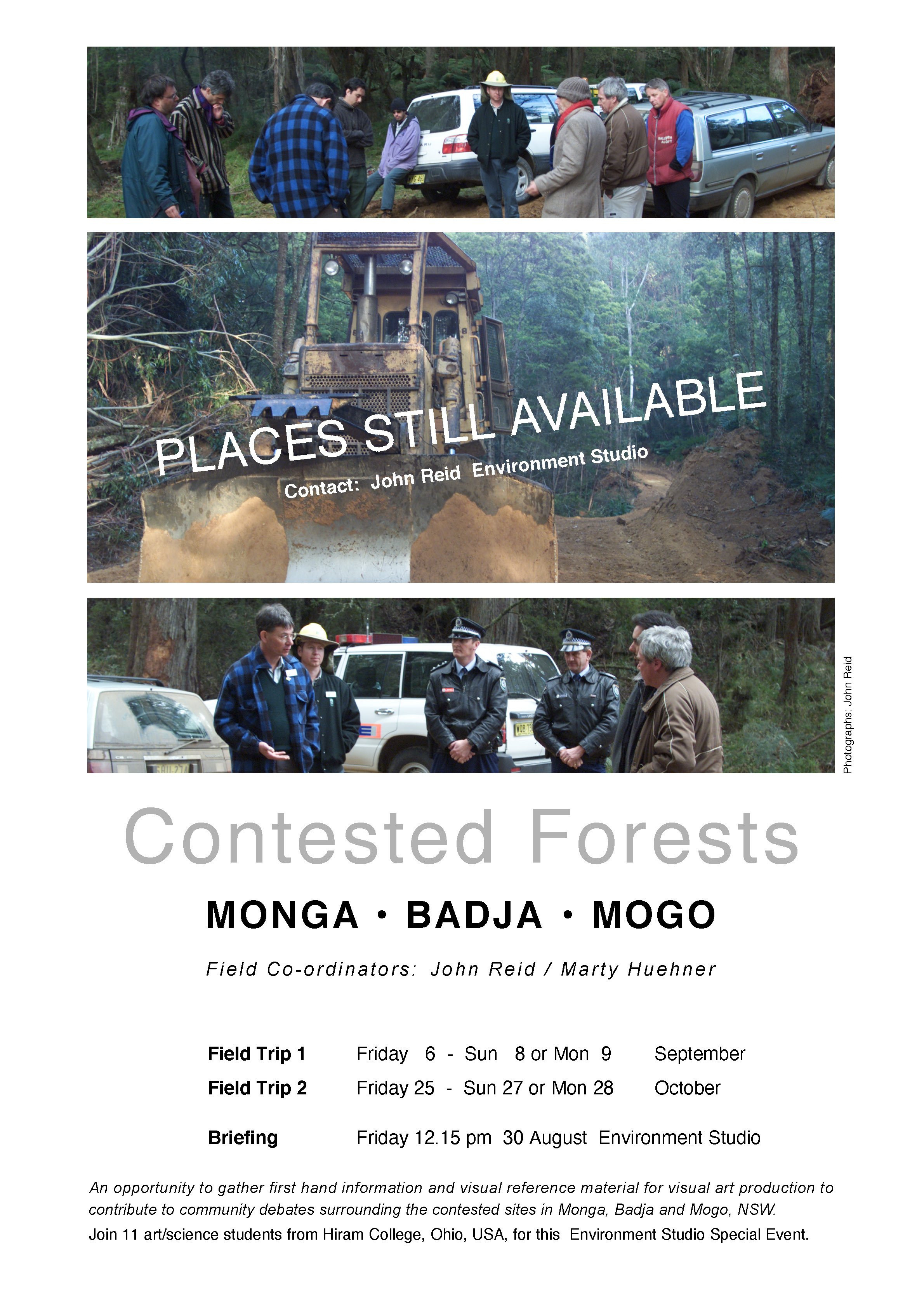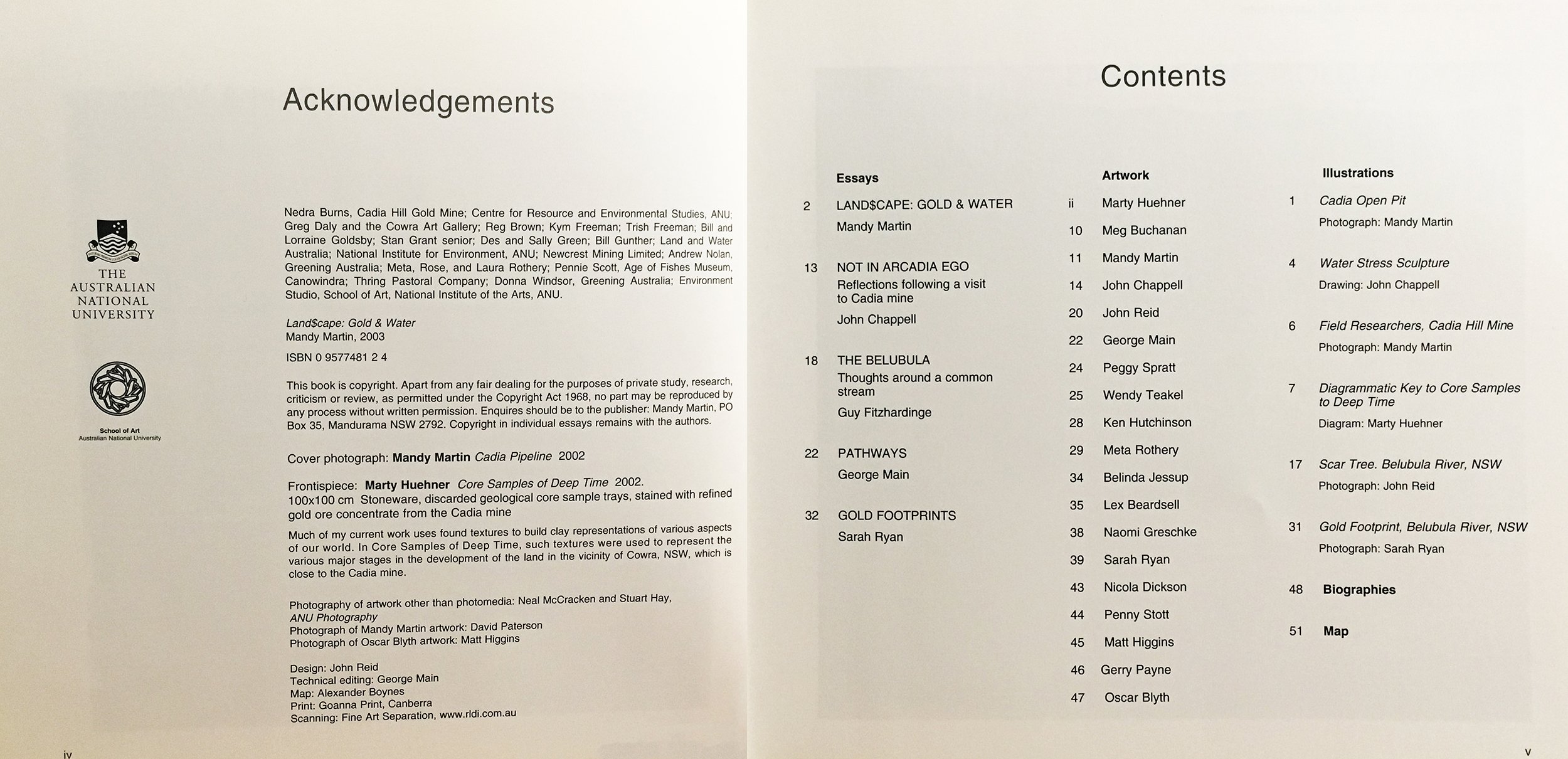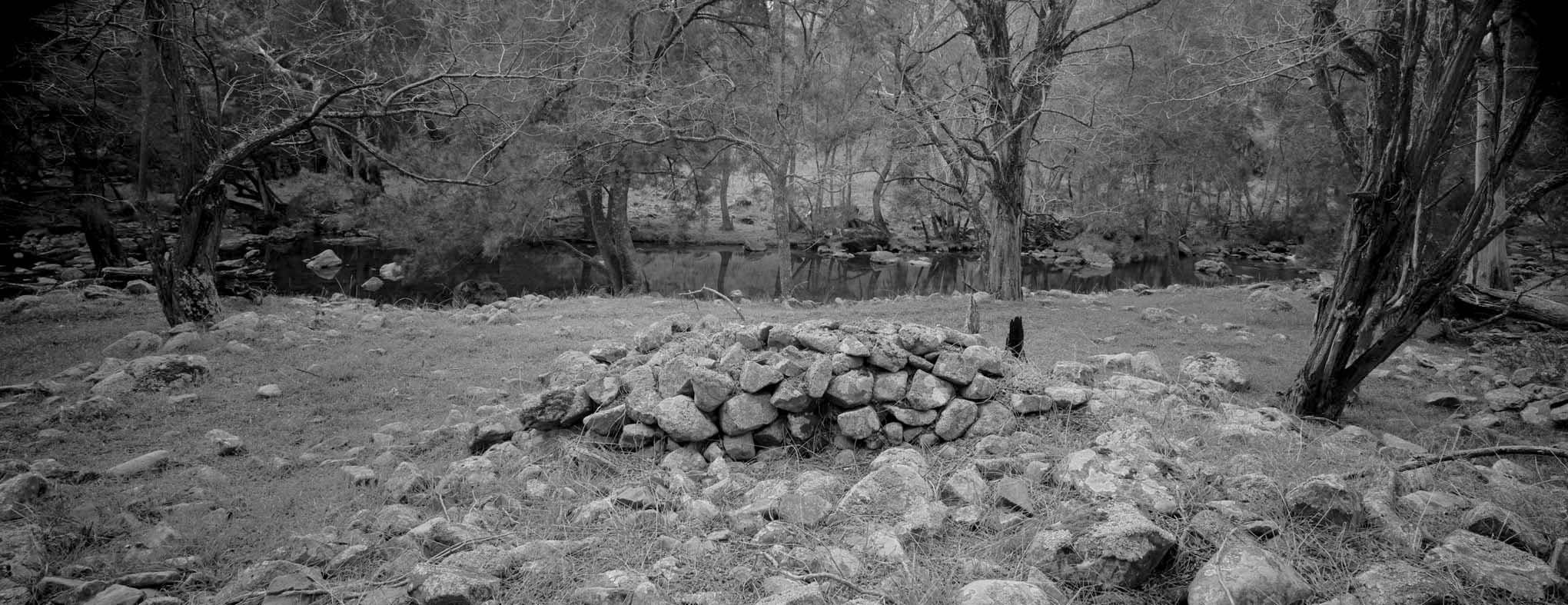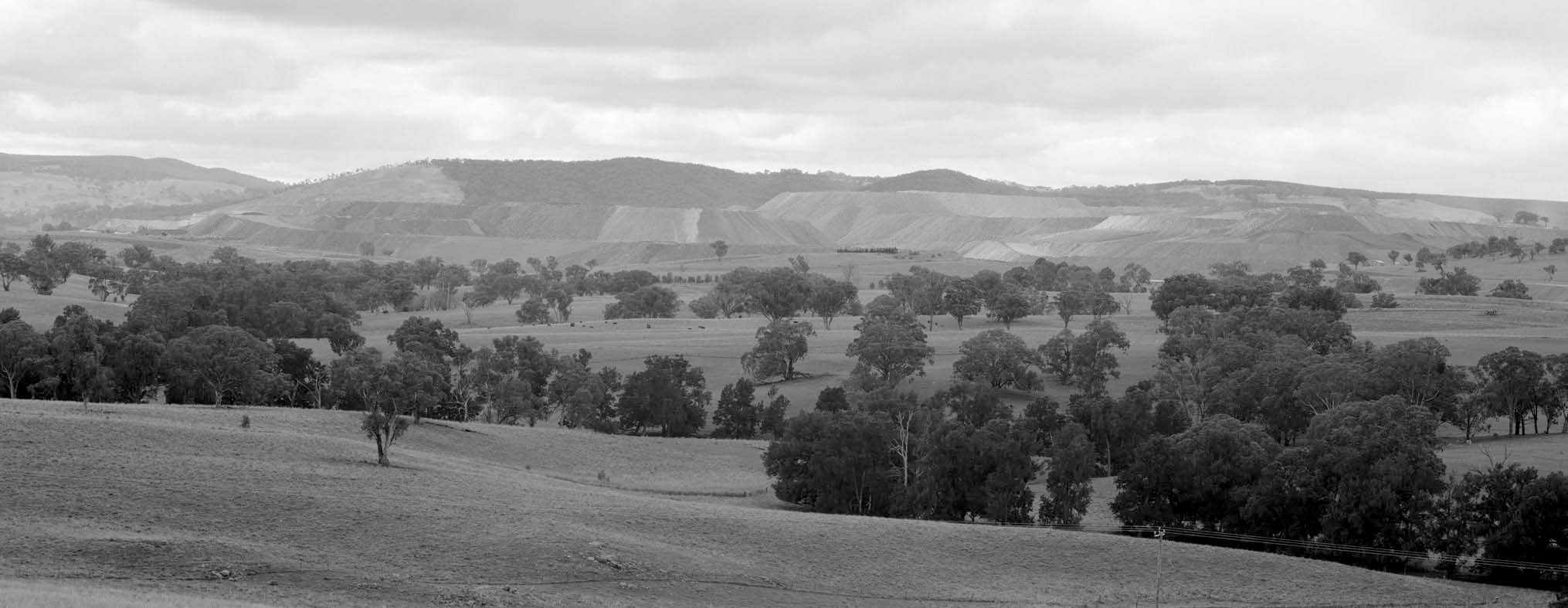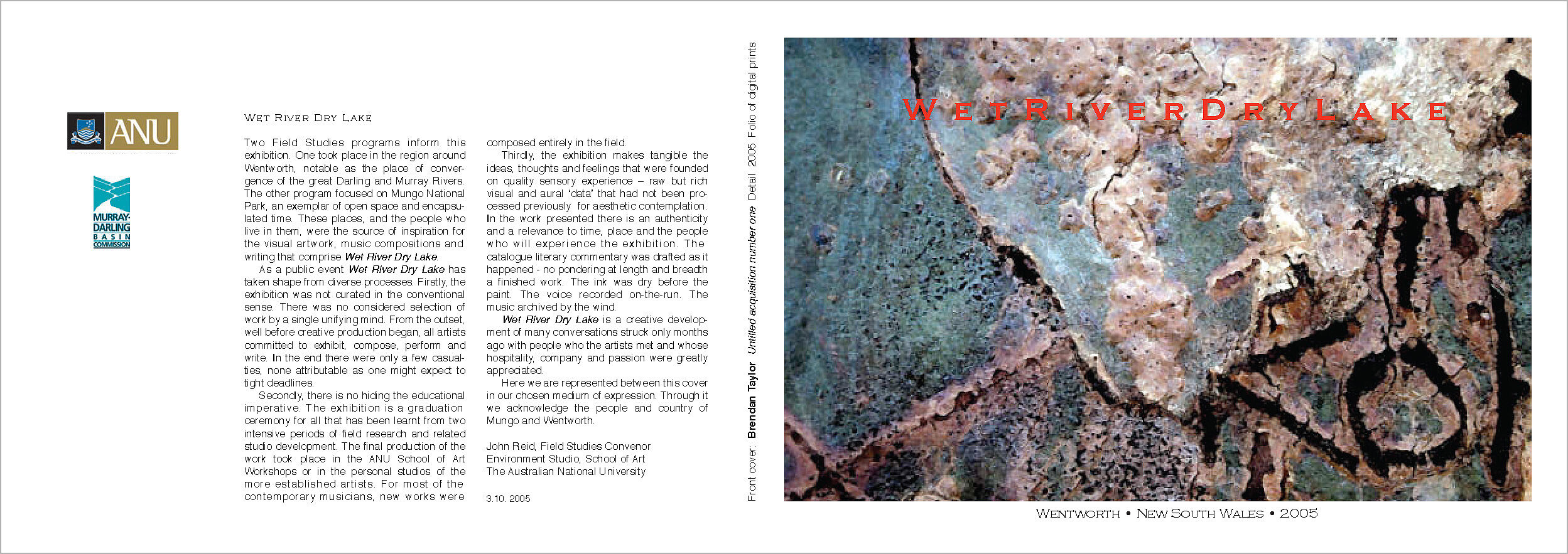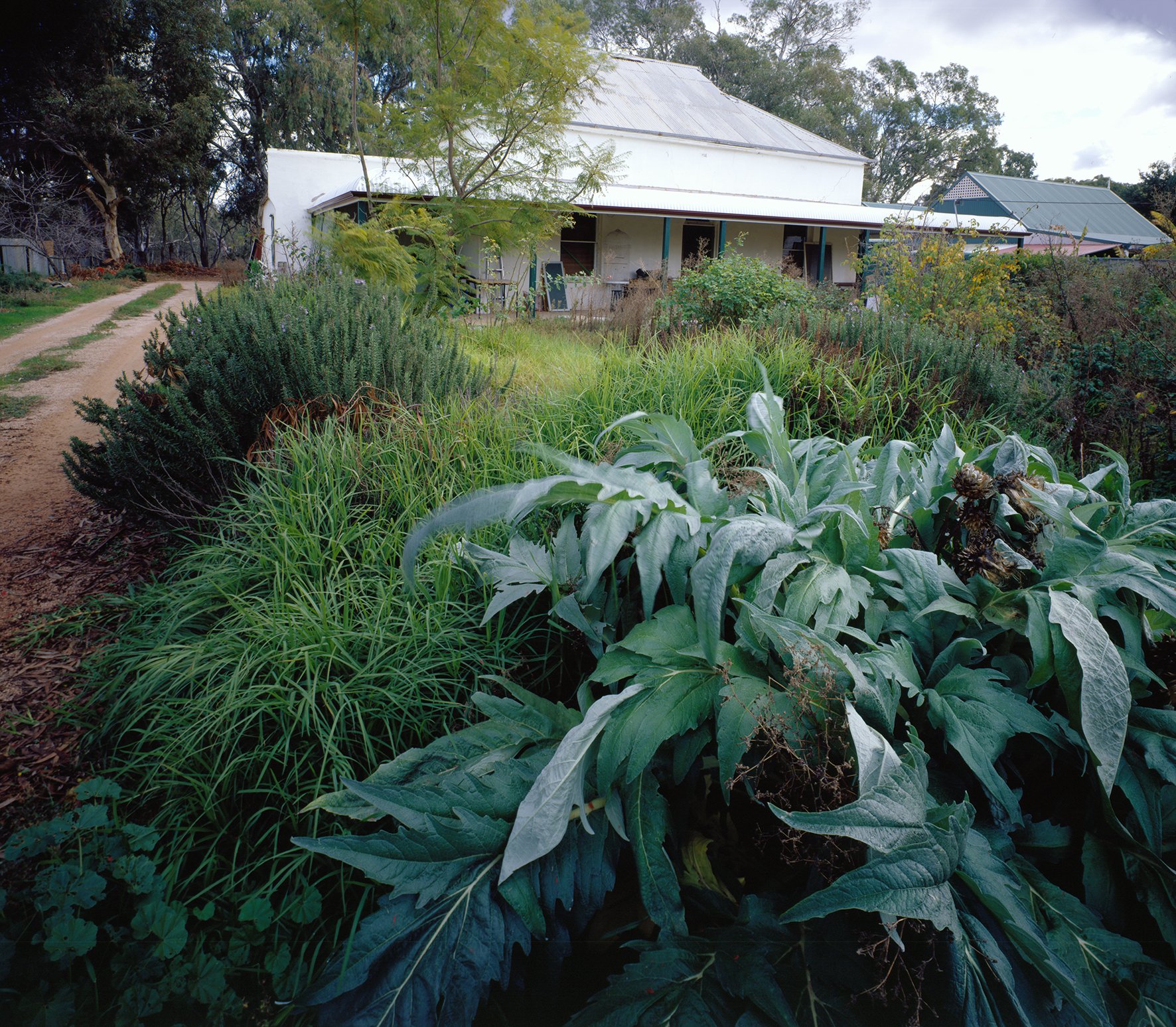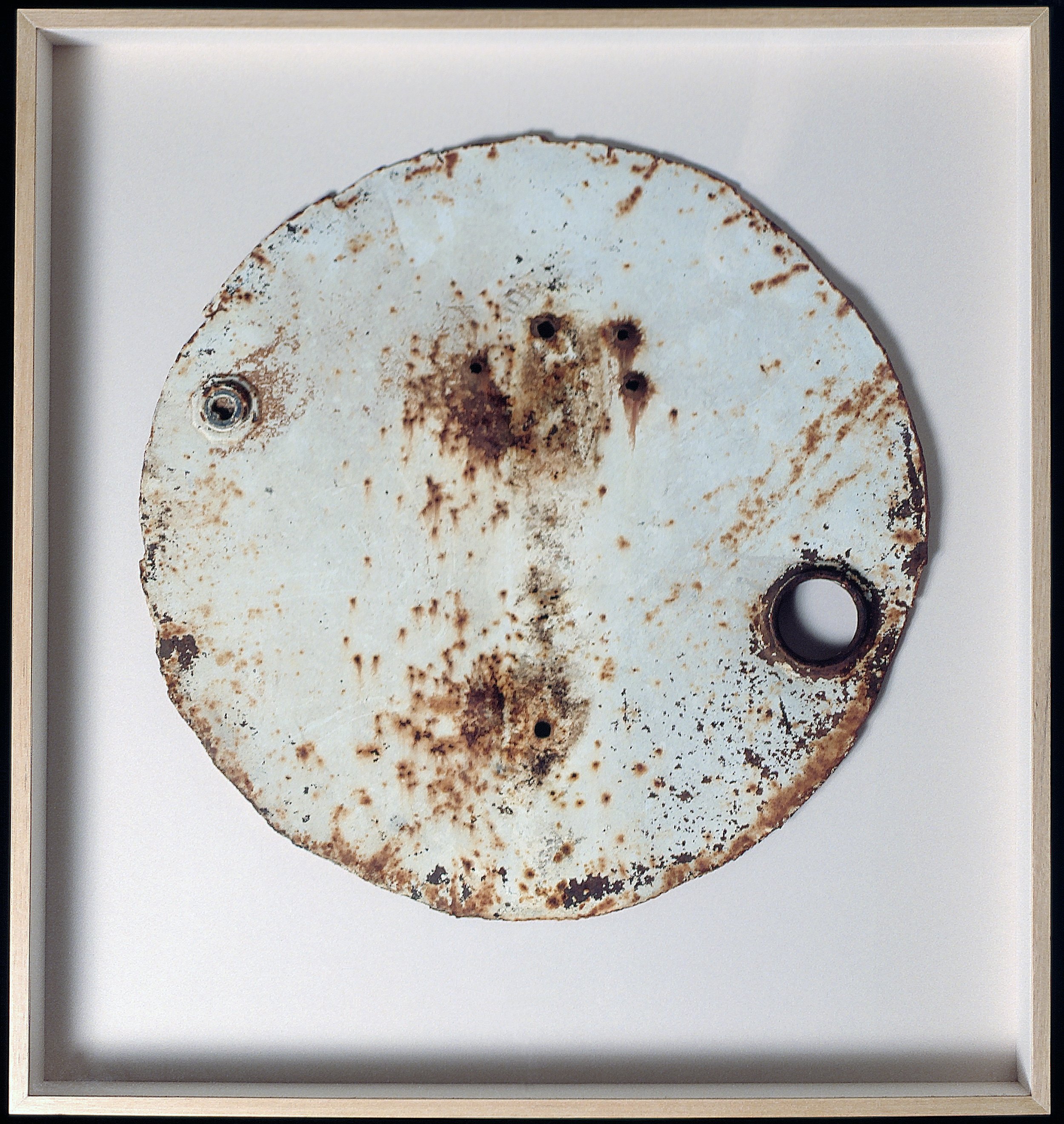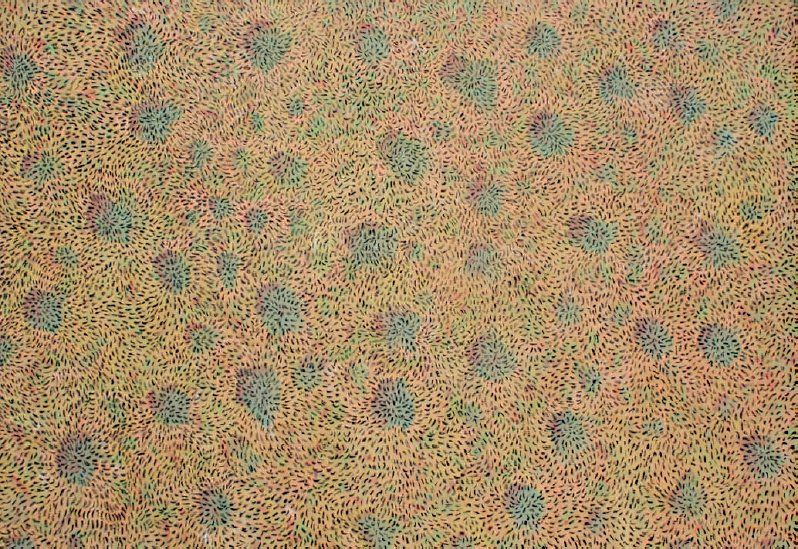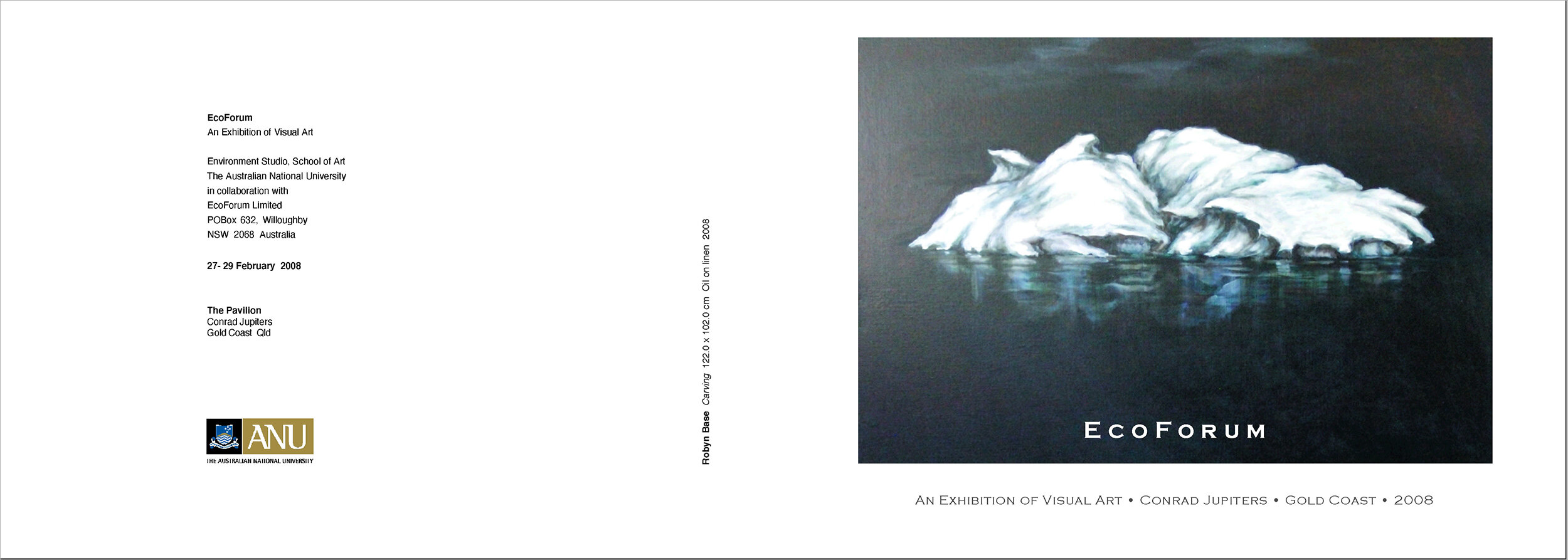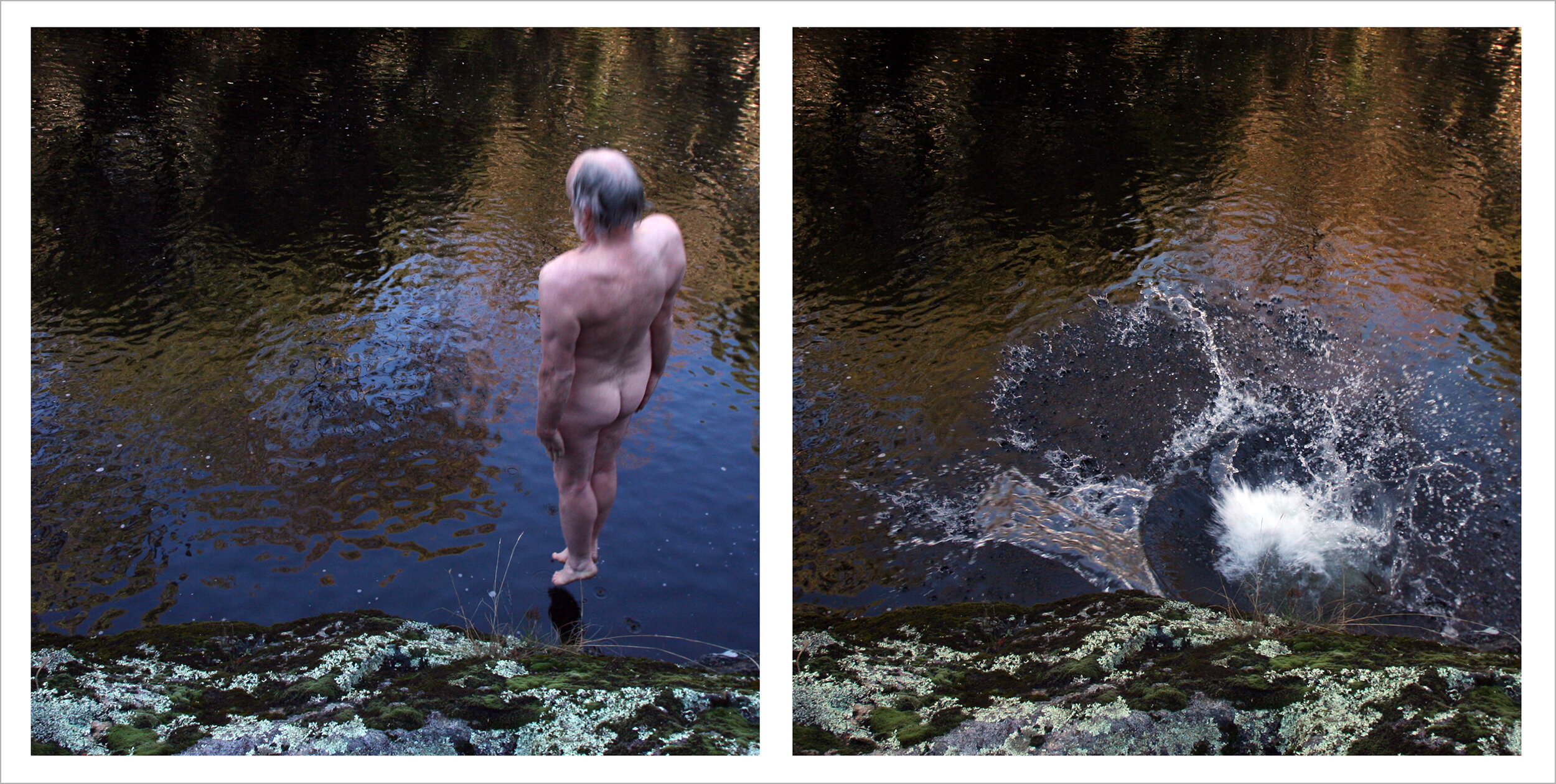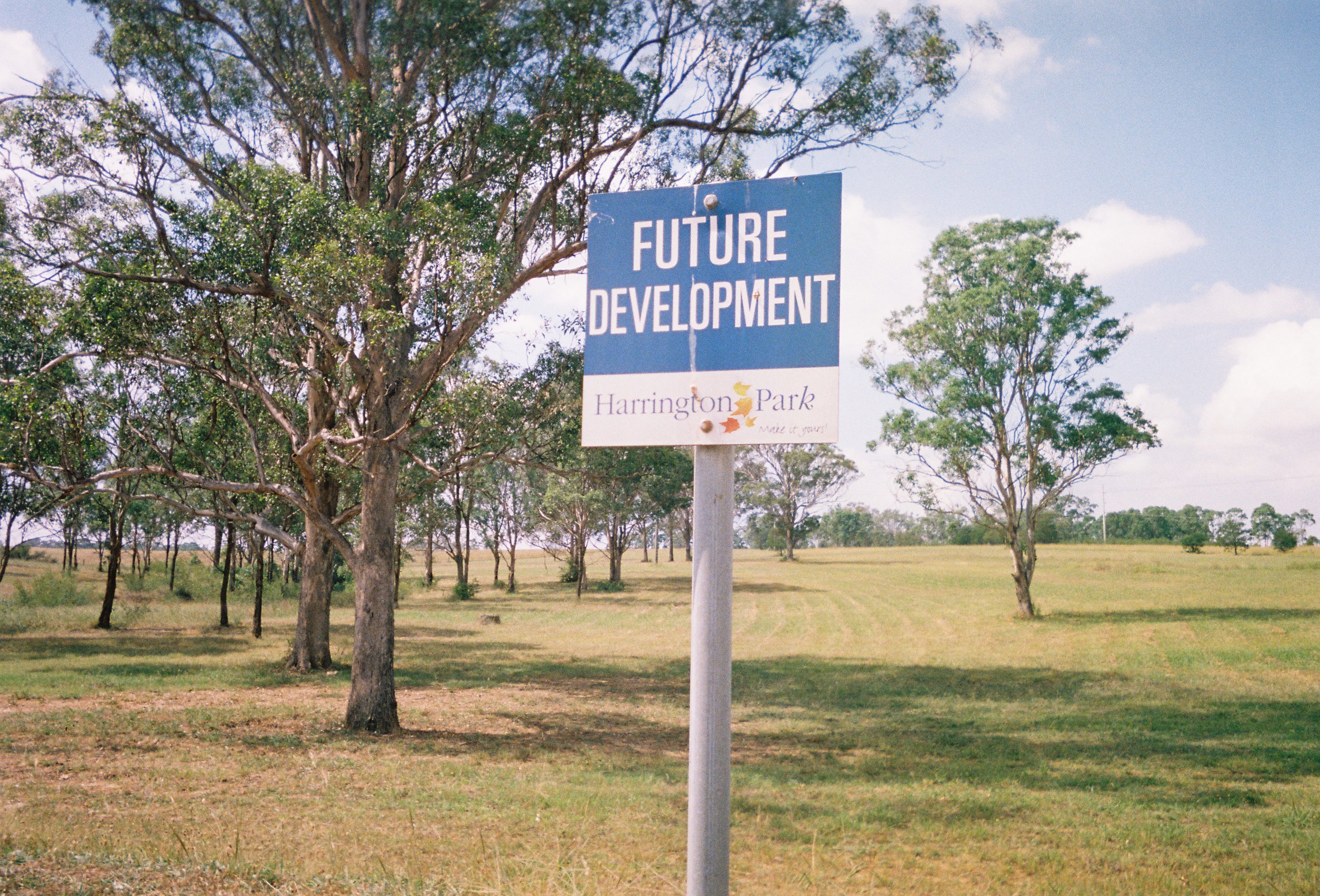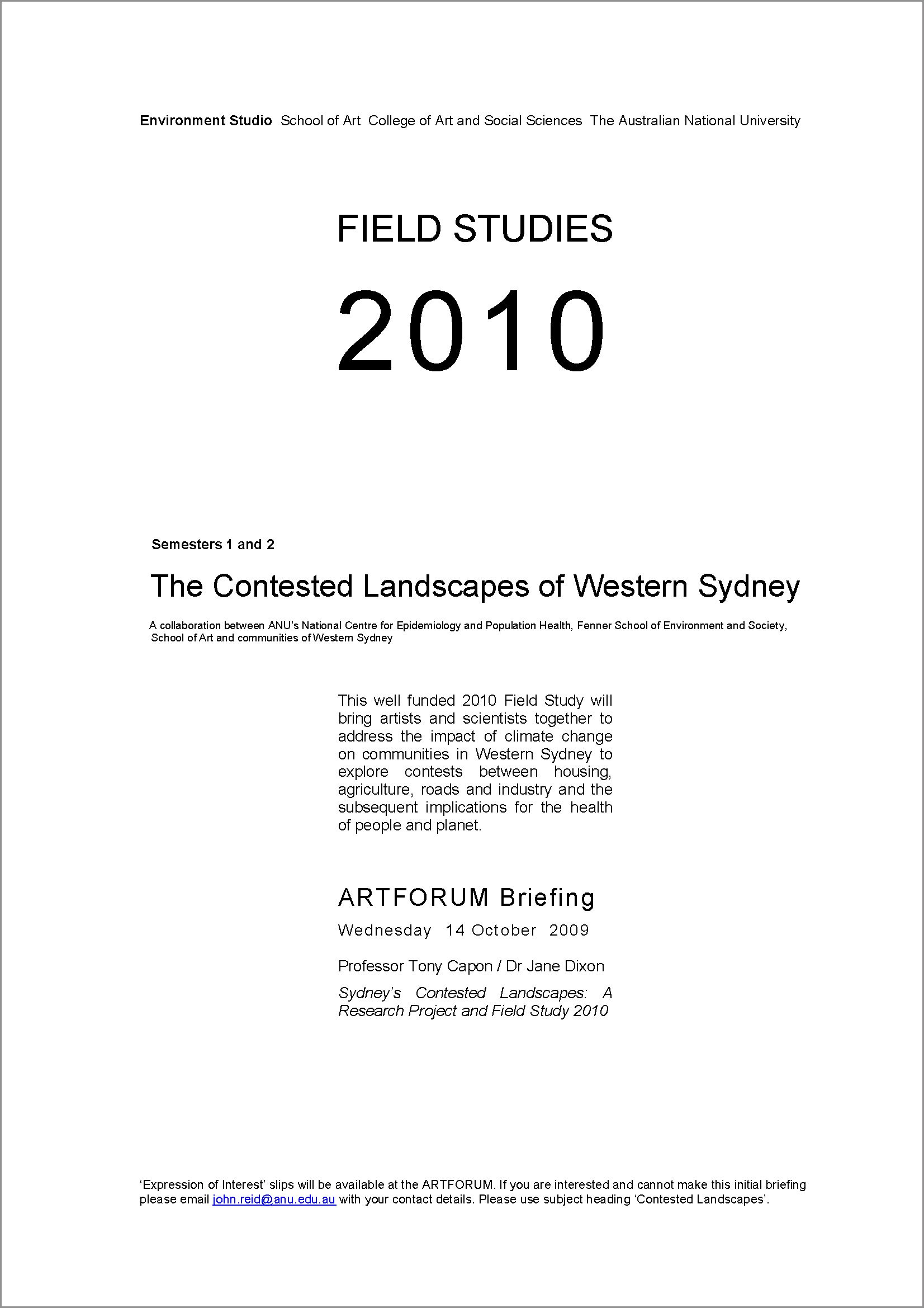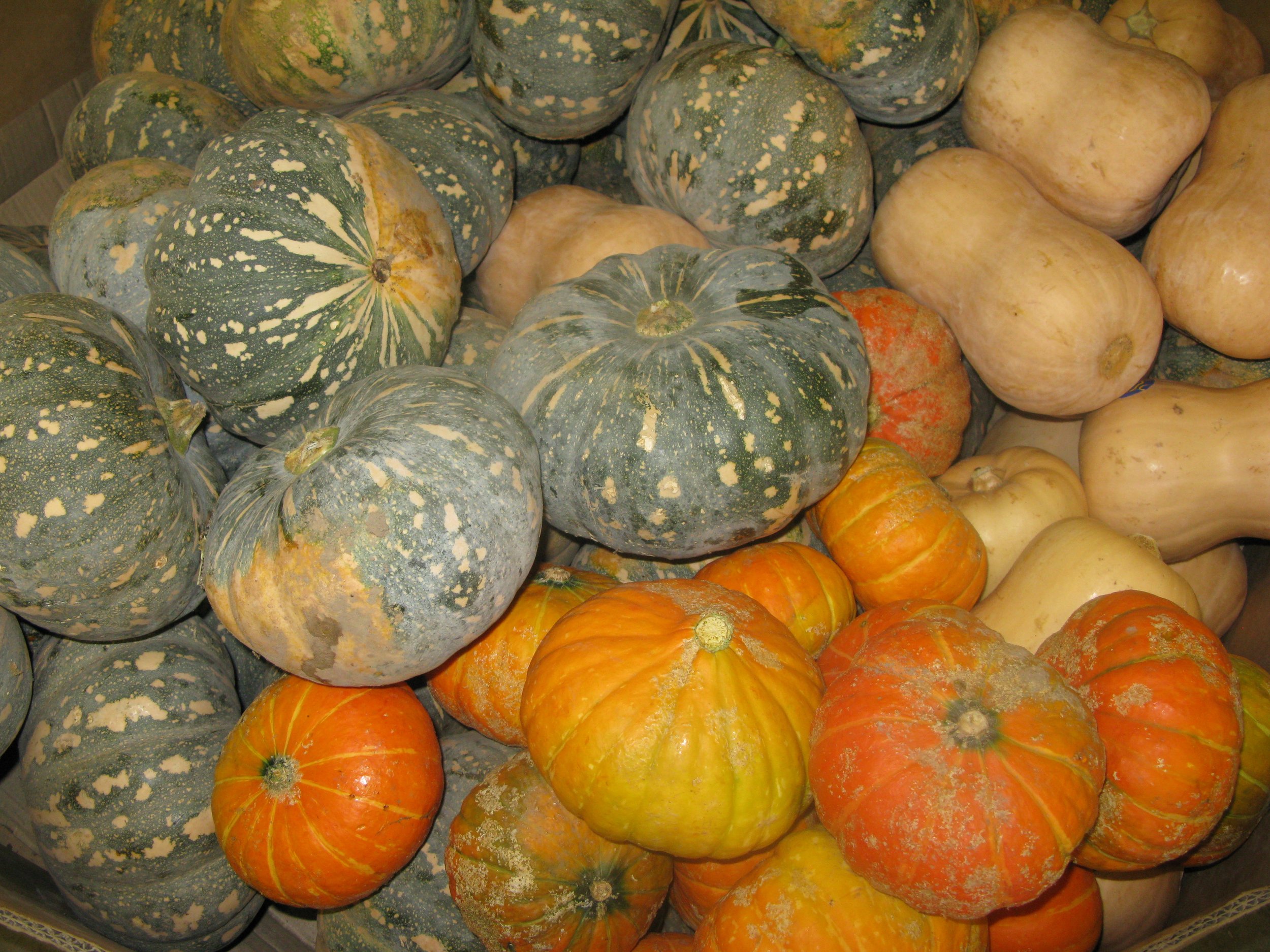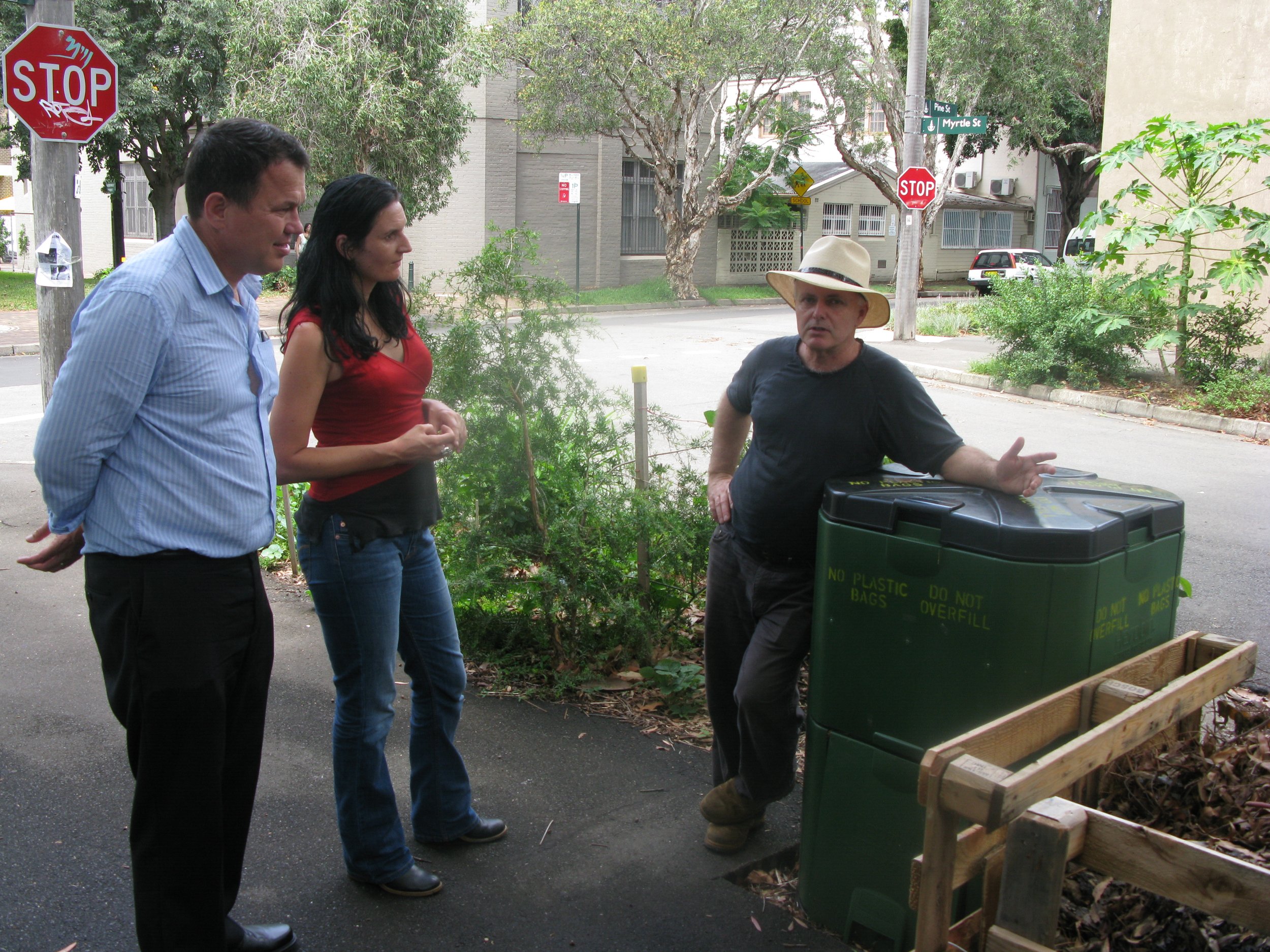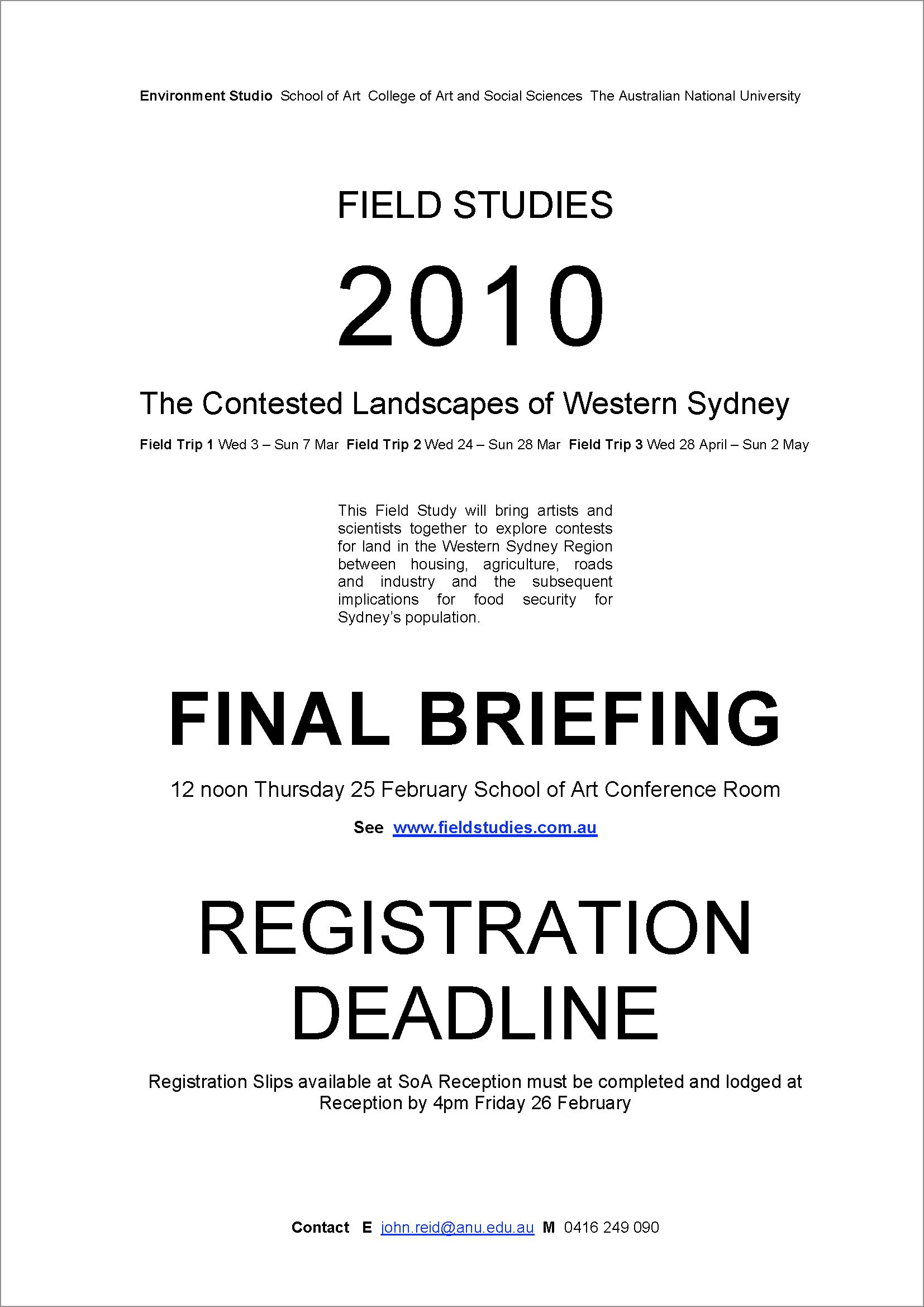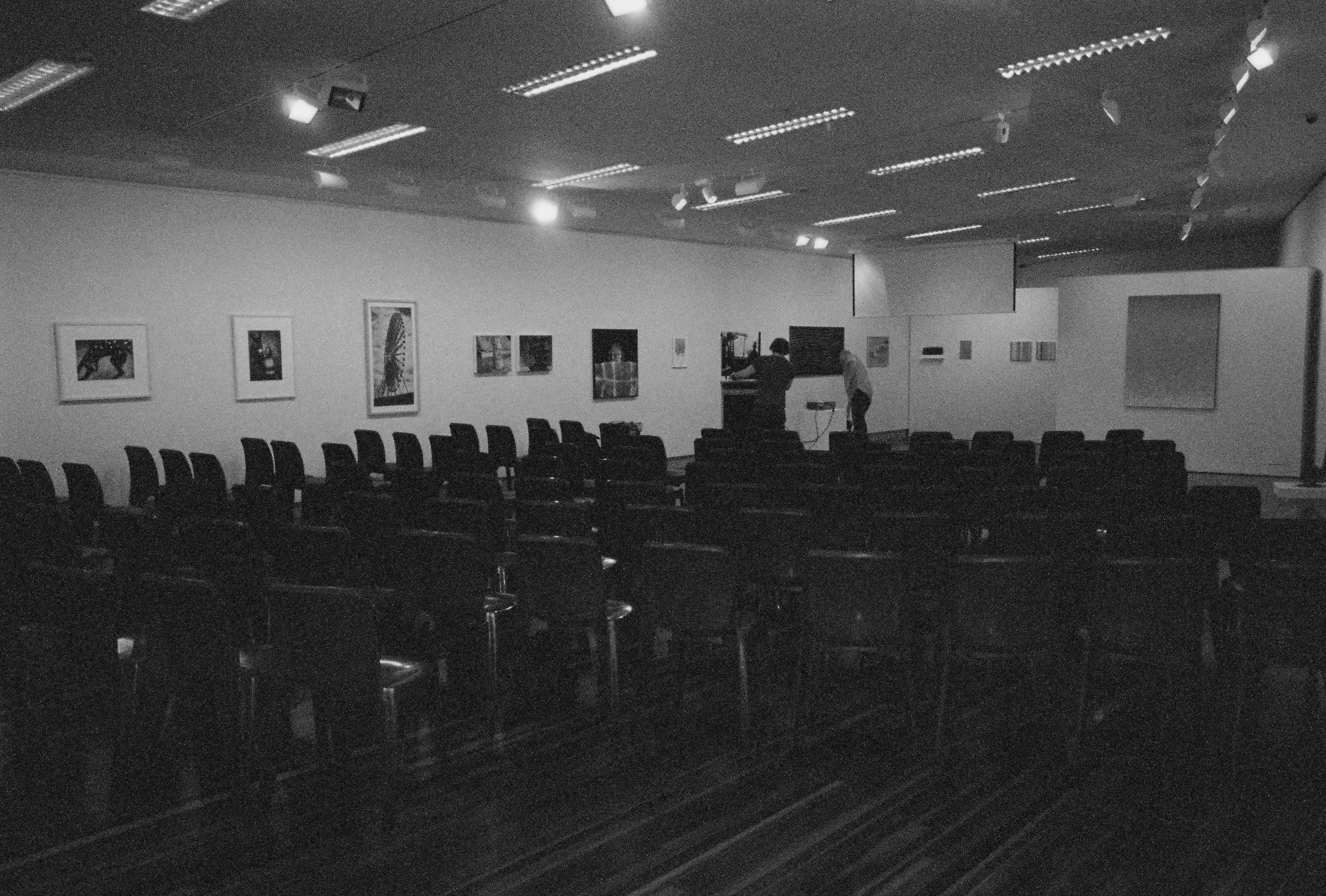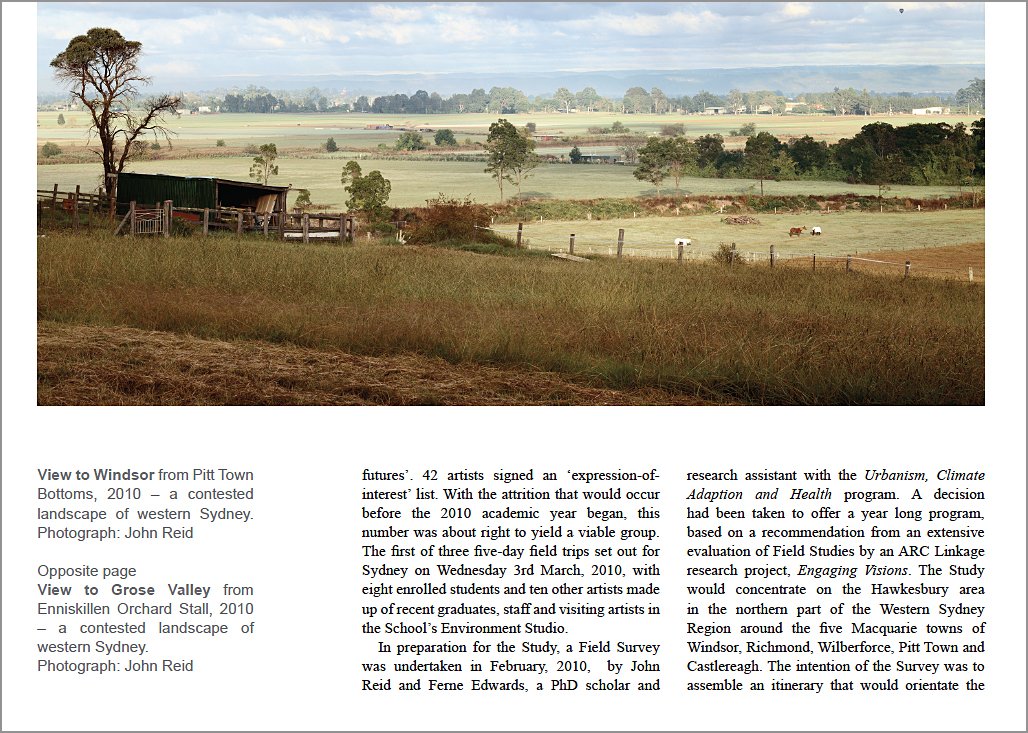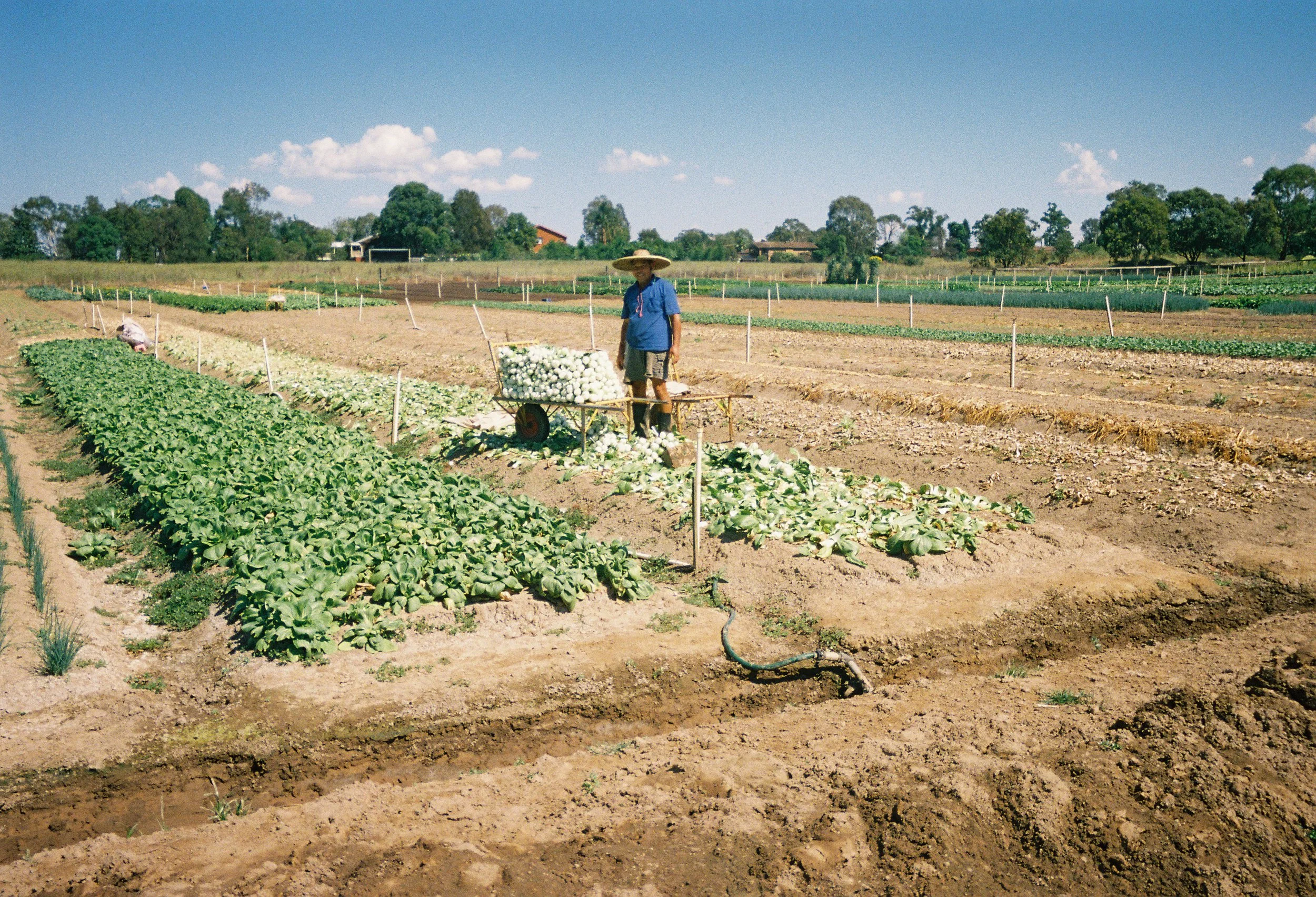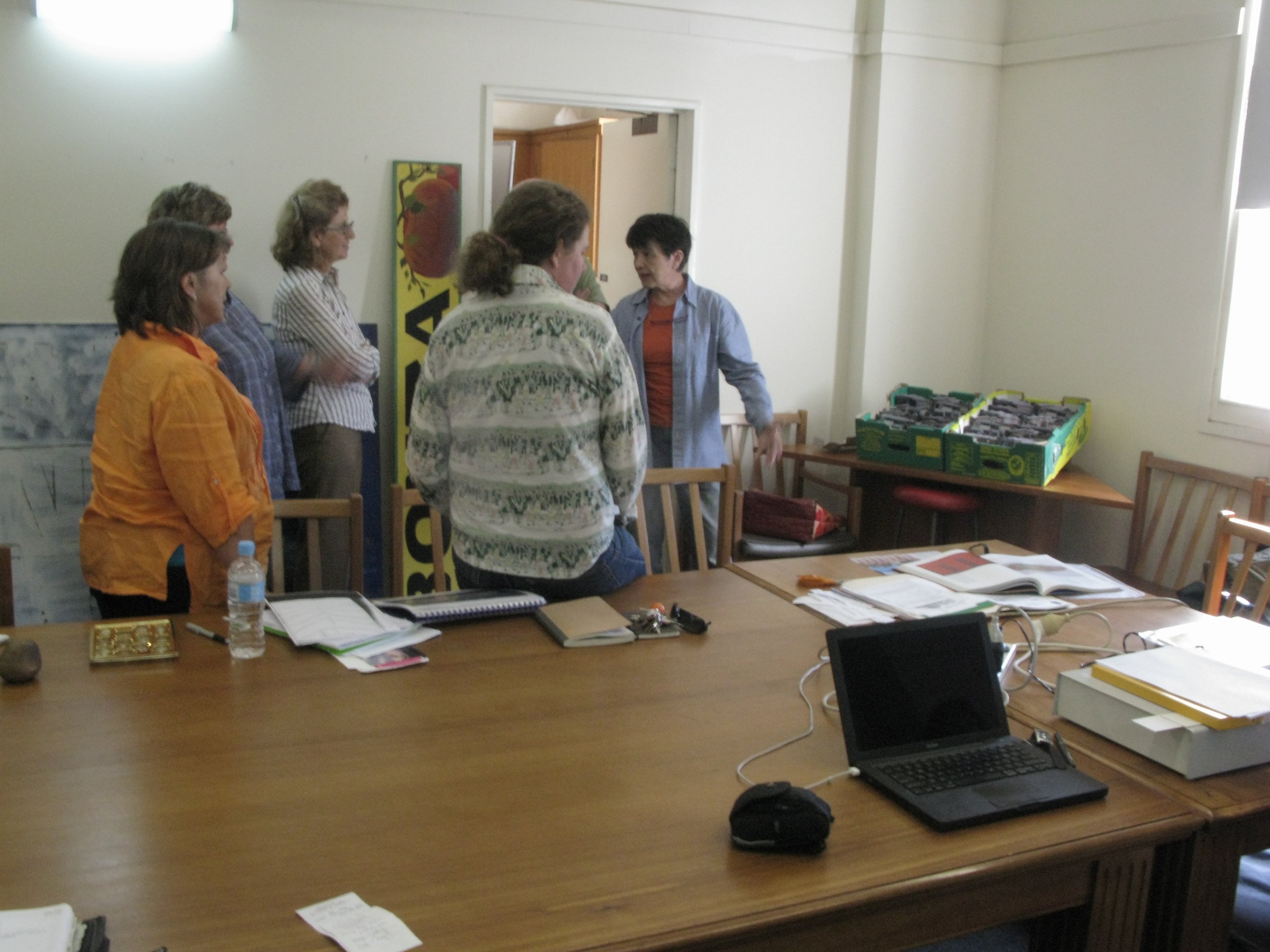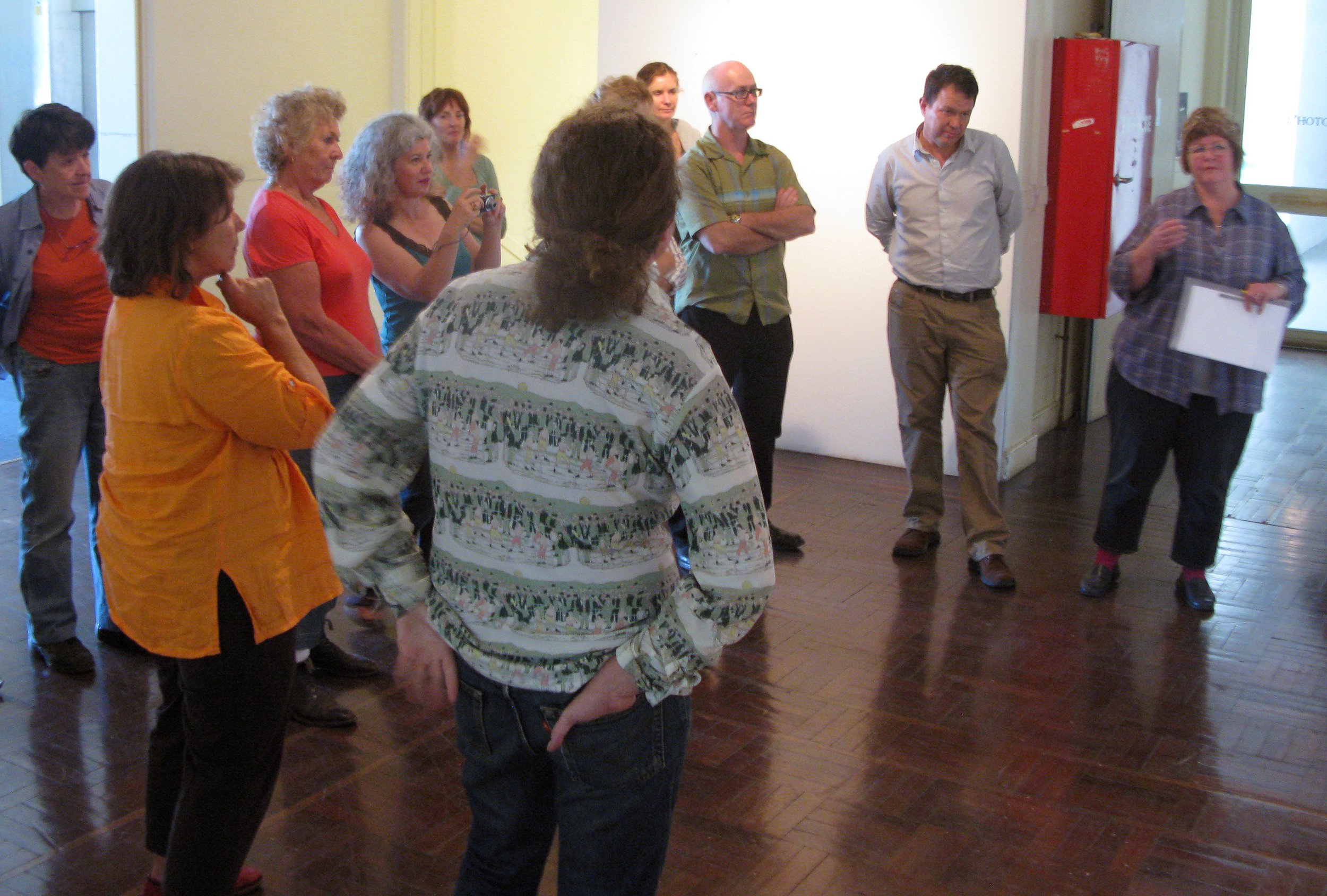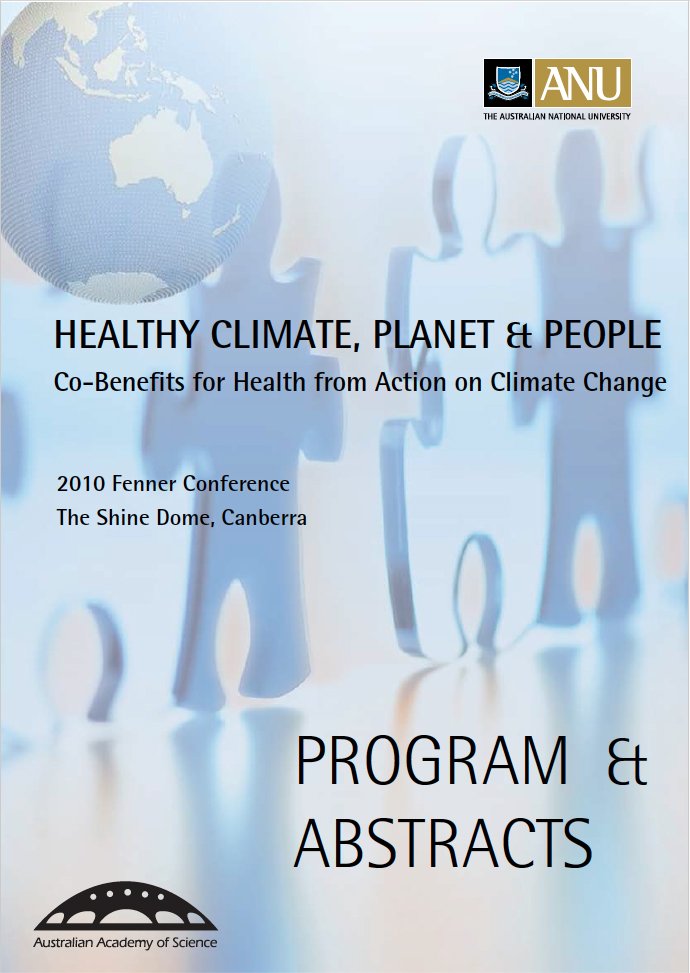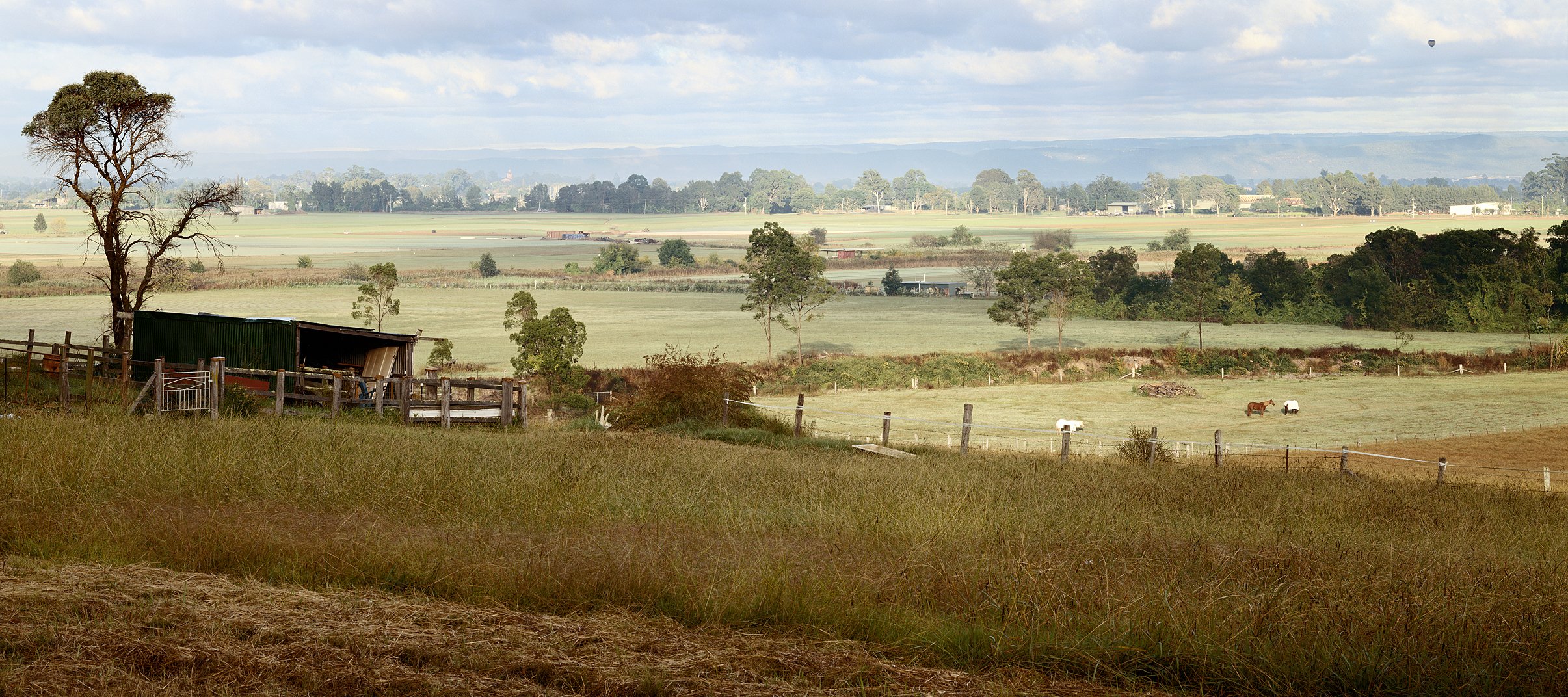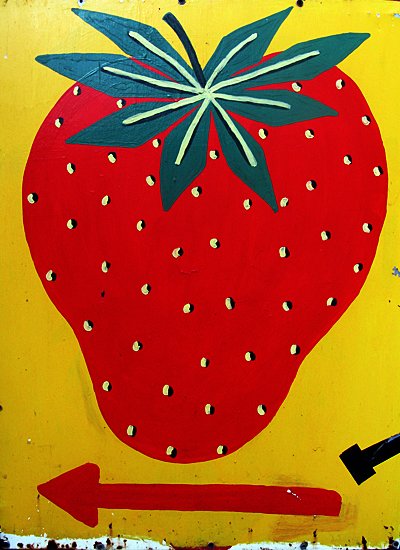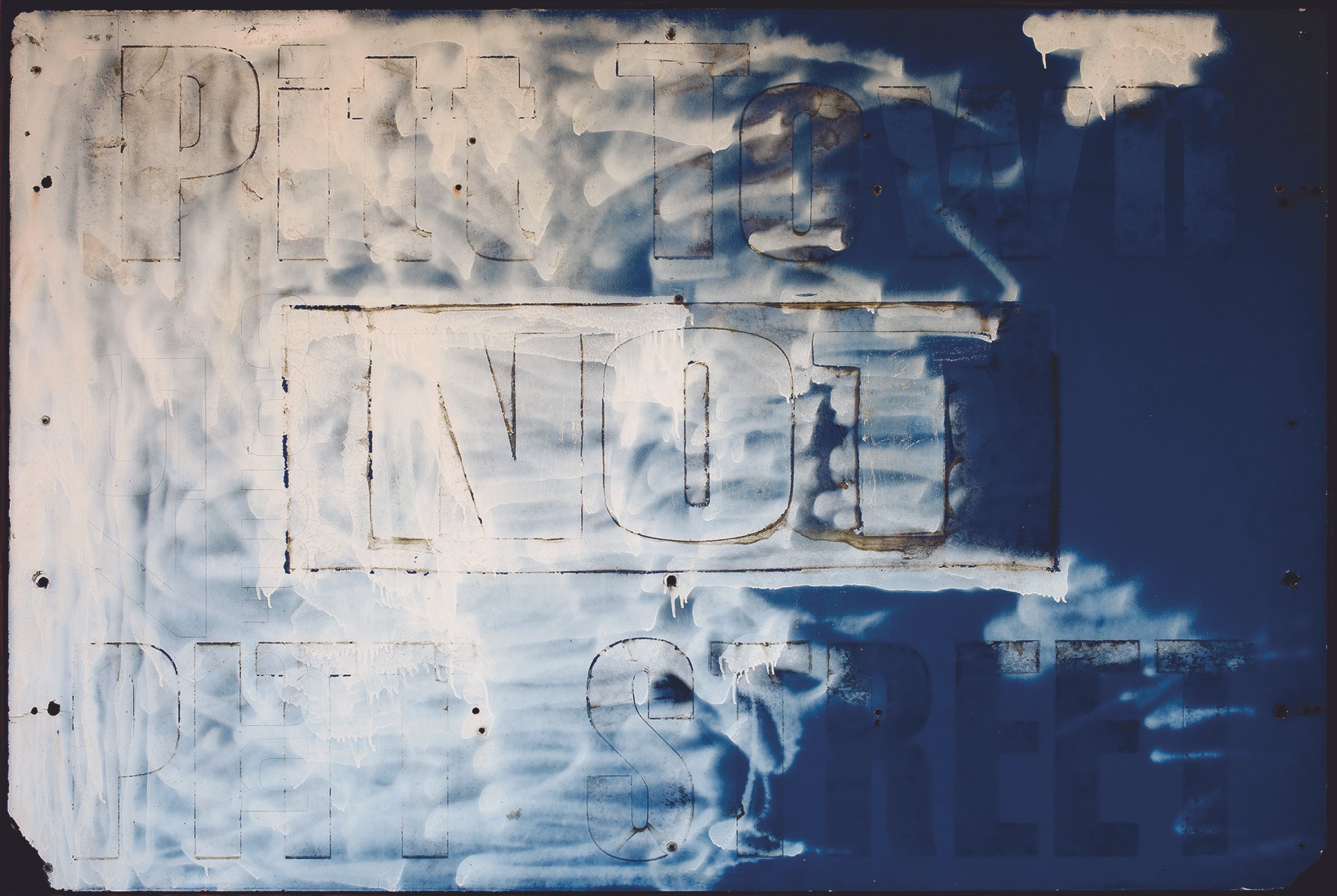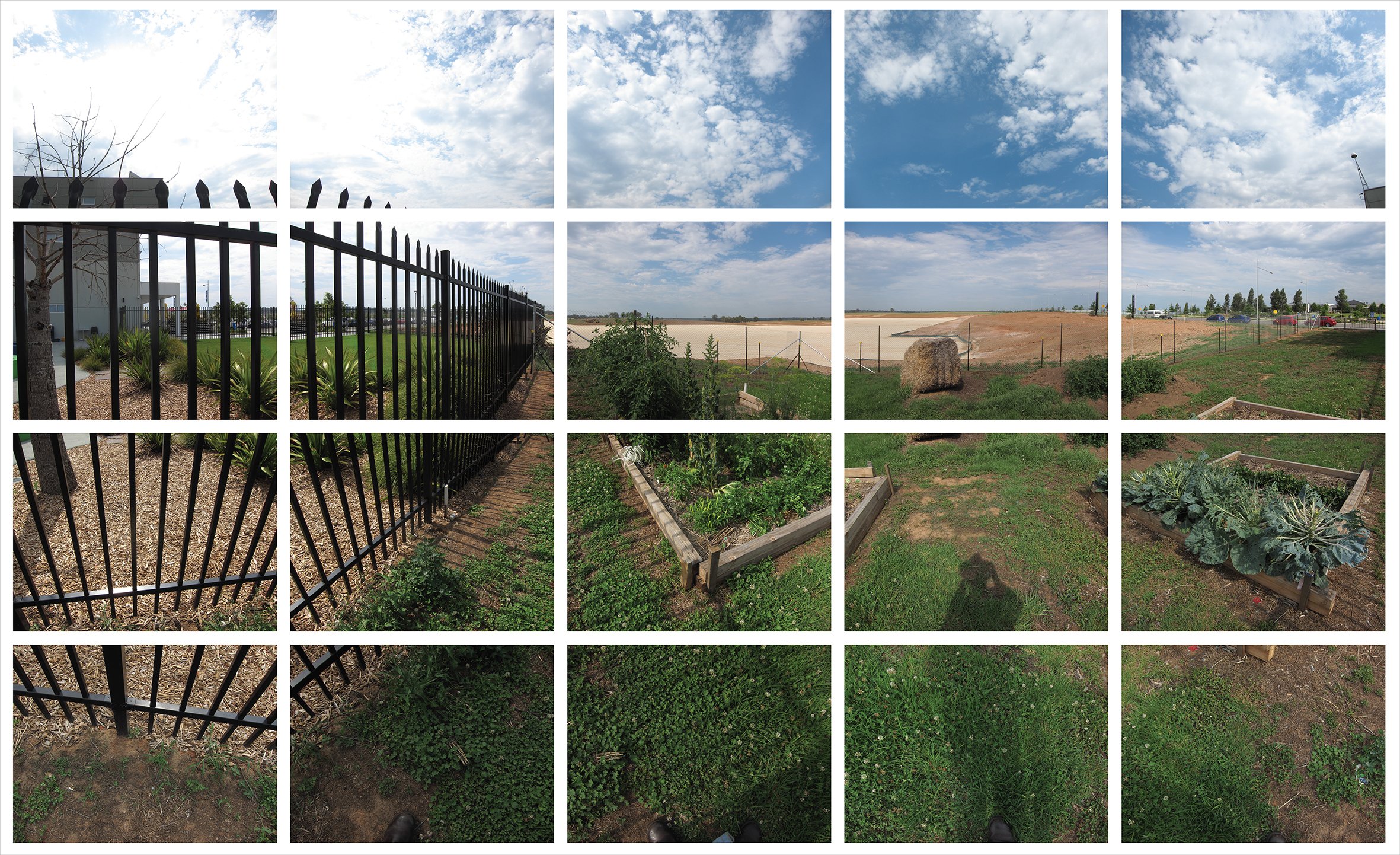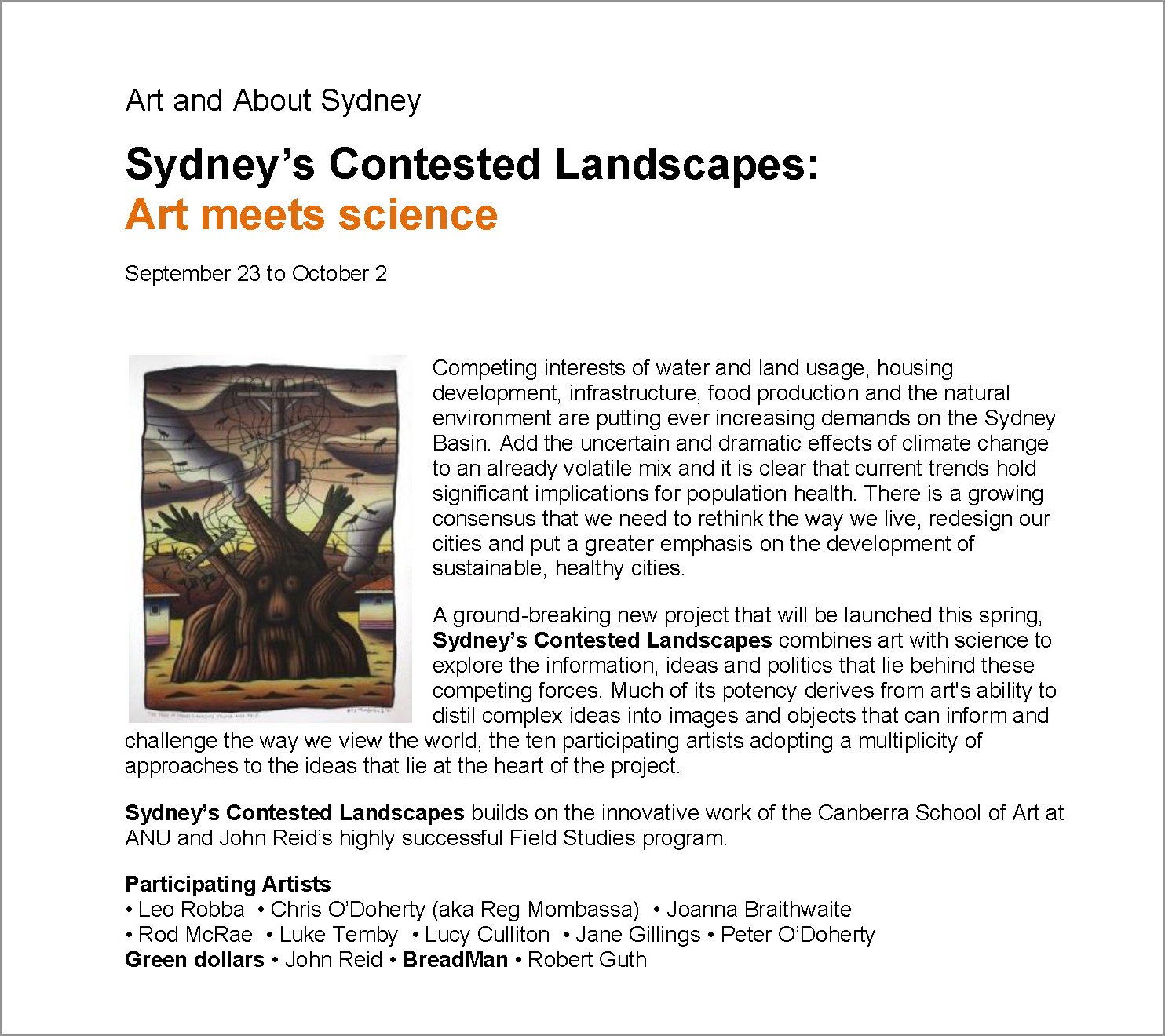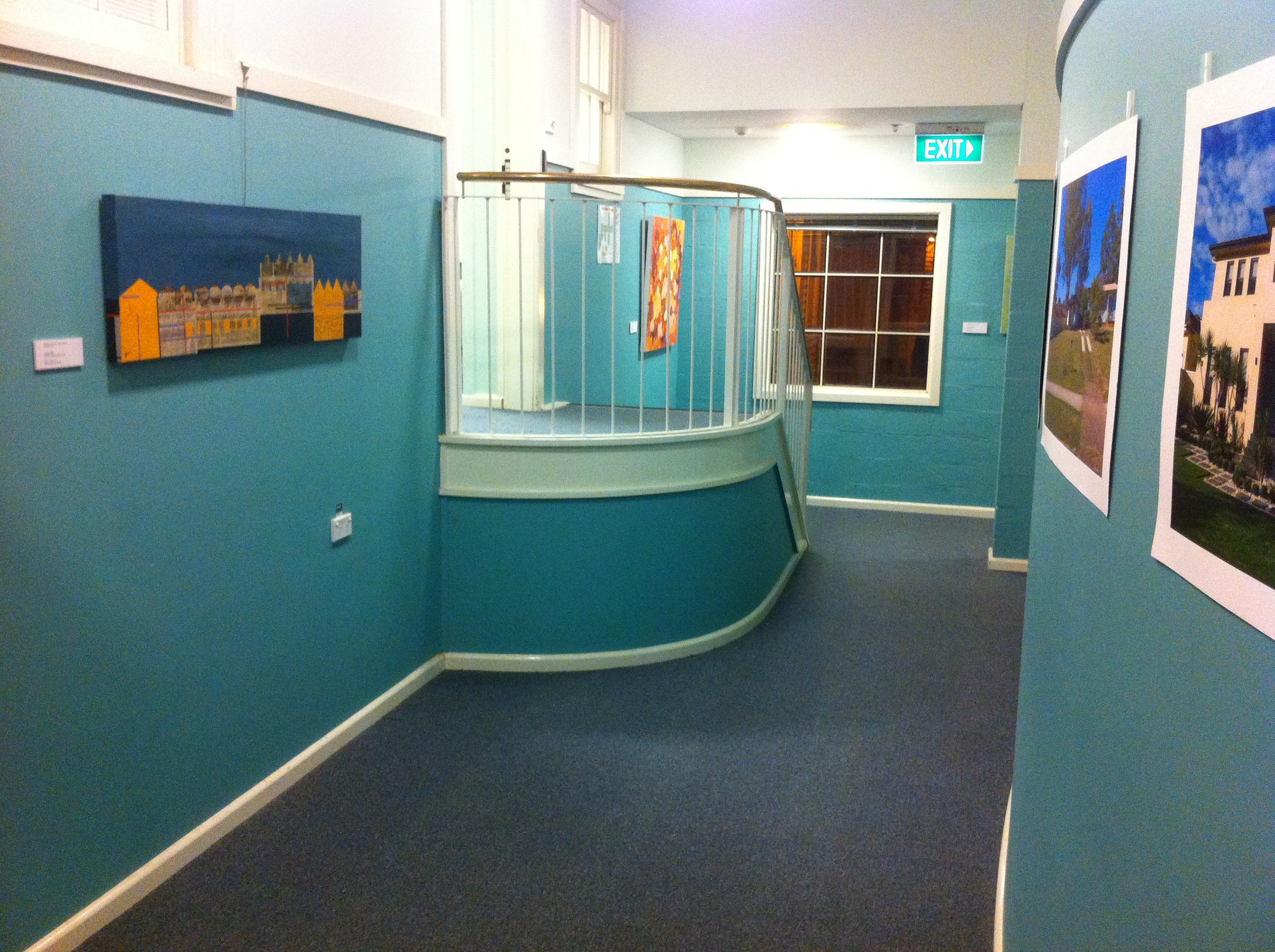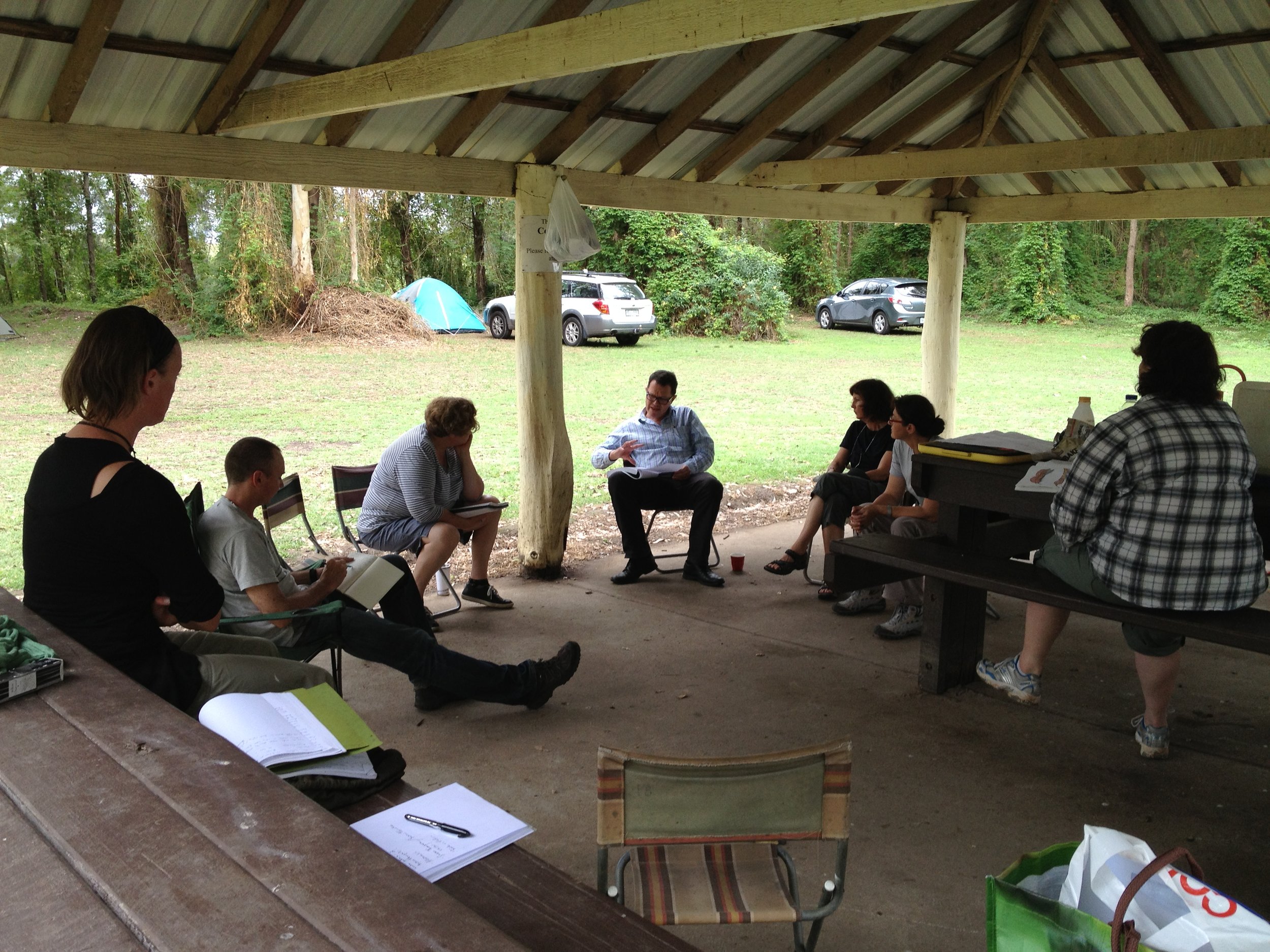Field Studies Programs
Last up-date to this page 31.03.2024
Daniel Maginnity Untitled 1996 Eucalyptus sticks. Blue Waterholes / Kosciuszko Field Study 1996. Photograph: John Reid / 8x10" transparency
Australian National University | School of Art
Environment Studio Field Studies Program 1996-2014
Convenor: John Reid
The Australian National University (ANU) School of Art Field Studies Program was first proposed in 1994 and finally established in 1996. Its procedures drew heavily on observations of student experiences on numerous field trips undertaken by the School’s Photomedia Workshop from 1983 to 1995; and having received considerable conceptual support during 1995 from the ANU Centre for Educational Development and Academic Methods to embed action research (intuitively undertaken by creative artists) into a resourced and timetabled field-based procedure. The Program contributed to student teaching and learning in the visual arts at advanced undergraduate and postgraduate level by focusing solely on the determination and development of subject-matter which distinguished the Program from other School of Art courses founded on media skill development. In 2000, the Environment Studio was established to continue the delivery of the Program’s focus on landscape environments - in many cases nominated by students and ranging from coastal, to rural, alpine, urban and outback semi-arid locations. Some of these places afforded ample community consultation while others were remote and were accessed by backpacking. The principal component of the Program consisted of repeated trips (usually three) to a specific field location where sustained research opportunities emerged from quality sensory, emotive and reflective experiences to inspire the production of fine art. Studio development stemming from the fieldwork took place between successive field trips in the participants’ major Workshops. Artwork generated by the Program was integral to the students’ overall course requirements and benefited from School-wide critical dialogue with academic staff.
Programs were multidisciplinary and available to students in all of the School’s Workshops. Several Programs involved musician/composers from the ANU School of Music Contemporary Music Ensemble. Other Programs included artists from the Sydney Gallery School, Technical and Further Education, NSW; artists from Charles Sturt University, Wagga Wagga, NSW; and architects from the School of Architecture and Design, RMIT University, Melbourne, Vic. ANU School of Art alumni and visiting artists often joined a Program as did some staff when teaching schedules permitted. Visual artists living in the field location were always invited to participate in the field experiences which often complemented daily vehicle excursions with light aircraft flights and guided river tours by boat. The Program’s creative cycle usually extended over two semesters and culminated in public exhibitions and performances both in the field location and at the ANU School of Art. Drawing on the findings of the Engaging Vision Research Project (a Linkage Project administered by the ANU, funded by the Australian Research Council and partnered by the Murray-Darling Basin Commission/Authority), Field Studies Programs from 2009 were configured into two phases - Phase 1: artist consultation with community and Phase 2: artist-community engagement. The consultation phase ended with the public exhibitions which, in turn, provided the community members with a clearer insight into the contribution that the creative arts could make to articulating cultural values and pressing social affairs, and laid the foundations for Phase 2: genuine artist-community consultation. (More detail later in this text).
Programs from 1997 to 2006 benefited from field intelligence and regular financial support from the Murray-Darling Basin Commission’s Information Division. Aboriginal Elders; community leaders; landholders; Shire and Catchment Management officials; State National Park rangers; local activists; local artists; researchers in the sciences and humanities; and politicians generously briefed Program participants usually on-site allowing the visual observation of landscape issues under discussion. Funding support and academic input also came from: the Commonwealth Scientific Research Organisation through the ANU National Centre for Epidemiology and Public Health; the National Climate Change Adaptation Research Facility through associated University of Canberra and the University of Wollongong research projects; the People and Place Research Program, University of Canberra; the Goulburn Broken Catchment Management Authority; Bush Heritage Australia; the National Museum of Australia; EcoForum Ltd; and numerous commercial agencies and community organisations operating in the various field locations.
The Field Studies Program was the recipient of National Carrick Award for Excellence in University Teaching (2006) and was the beneficiary of the Engaging Visions Research Project (2007-10), which was an initiative of The Australian National University in collaboration with the Murray-Darling Basin Commission/Authority and financially supported by the Australian Research Council (Linkage Grant).
Evaluations of participating artists and engaged community members in the four Field Studies Programs undertaken under the auspices of the Engaging Visions Research Project greatly refined the Program’s procedures. [See Young C, Reid J, Meehan B, Taking action: researching an innovative pedagogy for an aesthetic visual approach to environmental issues. Current Opinion in Environmental Sustainability (2015) at www.sciencedirect.com and below]. The most salient realisation that emerged for me from the Engaging Visions Research Project was that the exhibition should be positioned well within the time span of the procedure, not at its conclusion. The community at large gets its best insight into what the Field Studies Program can offer when it sees the visual art exhibited and performances delivered. Also artists can receive pertinent community feedback after their work is exhibited. It’s at this point that the artists and community could proceed from a consultation phase in the procedure to a genuine creative engagement founded on joint experiences arising from field work and focused in the exhibition.
Between 1996 and 2014, 51 Programs were delivered in New South Wales, Victoria, Queensland and South Australia - one was jointly delivered in Poland with the Academy of Art, Szczecin, to meet the interests of an ANU School of Art exchange student based in Paris; and another Program on the Far South Coast of NSW was energised by the participation of several artists from the kindred Landarts of the American West Program delivered by the University of New Mexico, USA. All Programs were convened by John Reid and field co-ordinated over the Program’s operation by several ANU School of Art Staff. The Program also delivered a number of one-off, 3-5 day Special Field Events usually centred around international artists visiting the School of Art. In 2006 and 2007, the Program procedure was adapted to meet the curriculum of ACT Secondary Colleges and was delivered at the ANU Coastal Campus, Kioloa NSW. A modified Field Study was also delivered in 2014 to NSW secondary students attending the Environmental Education Centre, Brewongle, NSW. John Reid mentored three field programs for the community arts organisation, Four Winds, Bermagui NSW in 2017, which saw the Program procedure migrate from academia into the public sphere.
In 2014, ANU School of Art & Design funding significantly contracted. Student predilections for Field Studies Programs (that did not award academic points in its own right) faded under the more dollar-conscious, certification orientated tertiary educational predicament. It was time for change and time for Reid to retire from the ANU. The Environment Studio continued to thrive under the facilitation of Dr Amanda Stuart and her dedicated colleagues by offering a field-based course with engagement opportunities in and around the environments of the Canberra Region. The course stands alone and awards academic credit. More importantly, it wholeheartedly embraces long-overdue formal participation of First Nation artists to concentrate on the delivery of content cognisant of Australian Aboriginal sensibilities to Country.
See:
• A link to a downloadable PDF of the 2010 publication, Engaging Visions: Engaging artists with the community about the environment, on the Researchgate web site (researchgate.net) which presents an overview of the Engaging Visions Research Project intended for general readership. The book covers the Project's background, constituent elements, and outputs.
Above: Jacket (front and back) of the 148 page publication profiling the Engaging Visions Research Project
See:
• A link to a youtube video, Engaging Visions - Artists and rural Aussies engage on the Environment, produced in 2010 by ANU TV with Engaging Visions Research Project researchers.
Above: Still image from the video about the Engaging Visions Research Project produced by ANU TV
See below for:
• A 2015 paper, Taking Action: researching an innovative pedagogy for an aesthetic visual approach to environmental issues
• The initial Field Studies Program proposal, June 1995, to the ANU School of Art Academic Board
• An outline of Field Studies Programs, 1996-2014. Content is still to be added for some Programs.
• The 2006 Carrick Citation and supporting statements
__________________________________________________________________________________________________
Field Studies Program Proposal / School of Art Academic Committee 1995
John Reid: Photomedia Workshop
__________________________________________________________________________________________________
Blue Waterholes / Kosciuszko NP Field Study 1996
Convenor and Field Co-ordinator: John Reid
John Reid Cave Creek. 1996. 8x10" transparency. Blue Waterholes / Kosciuszko Field Study 1996
Flyer: Blue Waterholes / Kosciuszko Field Study 1996
Field Study camp site. Blue Water Holes, KNP. Blue Waterholes / Kosciuszko Field Study 1996. Photograph: John Reid / 8x10" transparency
Anne-Marie Jean Tent (Performance for the camera - Coolman Plain Homestead). Blue Waterholes / Kosciuszko Field Study 1996. Photograph: John Reid / 8x10" transparency
Aaron Pollock (diminutive figure in orange jumper, lower centre) investigates the surface of a limestone cliff face. Cave Creek. Blue Waterholes / Kosciuszko Field Study 1996. Photograph: John Reid / 8x10" transparency
John Reid Coolman Plain 1996. 8x10" transparency. Blue Waterholes / Kosciuszko Field Study 1996
__________________________________________________________________________________________________
Monga State Forest Field Study 1996
Convenor and Field Co-ordinator: John Reid
John Reid Field Study Monga State Forest NSW. 1996. 8x10" transparency. Monga State Forest Field Study
John Reid Artists and Geographers, Monga State Forest NSW. 1996. 8x10" transparency. Monga State Forest Field Study and Landscape Ecology Field Trip. 1996
The Monga exhibition poster - front. The exhibition presented artwork by both artists and scientists from fieldwork undertaken in 1996.
The Monga exhibition poster - back.
Cover. Artist Book (Edition of 7). Produced for, and launched at, the Monga exhibition.
Design: Dani Mellor. Printed at the Edition and Artist Book Studio, Canberra School of Art.
Cover photograph: John Reid / 8x10" transparency
Canberra Times, Saturday 23 August 1997
Cala Neice Untitled. 1996 Monga Installation. Photograph: John Reid / 8x10" transparency
Left: ‘In a Green Classroom …’ full page article. Right: ‘In a Green Classroom …’ Parts 1 to 3 of enlarged article.
‘In a Green Classroom …’ Parts 4 to 6 of enlarged article.
John Reid Field Study Monga State Forest NSW. 1996. 8x10" transparency. Monga State Forest Field Study. Andrew Wong, forest campaigner and Wilderness Society activist, (second from right), introduced the Field Study artists to the ecological features of Monga Forest.
Program Evaluation / Monga State Forest Field Study 1996
Dr. Kathleen M. Quinlan / Lecturer, Centre for Educational Development and Academic Methods / 9 September 1996
__________________________________________________________________________________________________
Murrumbidgee and the Hay Plains Field Study 1997
Convenor and Field Co-ordinator: John Reid
John Reid Murrumbidgee River, Birdcage Reserve, NSW. 1997. 96.0 x 116.0 cm. Digital print from a scanned 8x10 inch transparency. Murrumbidgee and the Hay Plains Field Study
Standish Kemmis’s outdoor studio, Murrumbidgee River bank, NSW. Murrumbidgee and the Hay Plains Field Study. 1997. Digital print from a scanned 8x10 inch transparency. Photograph: John Reid
Overnight camp. Murrumbidgee River bank, NSW. Murrumbidgee and the Hay Plains Field Study. 1997. Photograph: John Reid. Digital print from a scanned 8x10 inch transparency.
Murrumbidgee and the Hay Plains Field Study exhibition invitation
Looking south (Old Man Emu Plain) from the Murrumbidgee River, NSW. Murrumbidgee and the Hay Plains Field Study. 1997. Photograph: John Reid. Digital print from a scanned 8x10 inch transparency.
Murrumbidgee and the Hay Plains Field Study exhibition poster
Makeshift Gallery, Lachlan Street, Hay, NSW. Murrumbidgee and the Hay Plains Field Study exhibition venue. 1997. Digital print from a scanned 8x10 inch transparency. Photograph: John Reid
Artist Luke Nilsen in the gallery interior, Lachlan Street, Hay, NSW. Murrumbidgee and the Hay Plains Field Study exhibition. 1997. Photograph: John Reid. Digital print from a scanned 8x10 inch negative.
Artists (left to right) Veronica Wentworth, Daniel Maginnity and Luke Nilsen (sitting in the shadows) working at night in the in the gallery back room, Lachlan Street, Hay, NSW. Murrumbidgee and the Hay Plains Field Study. 1997. Photograph: John Reid. Digital print from a scanned 8x10 inch transparency.
John Reid Evening Meal Preparation, Murrumbidgee River bank overnight camping spot, NSW. 1997. 96.0 x 116.0 cm. Digital print from a scanned 8x10 inch transparency. Murrumbidgee and the Hay Plains Field Study 1997. Exhibition contribution
__________________________________________________________________________________________________
The Cultivated Landscape Field Study 1997
Convenor and Field Co-ordinator: John Reid
John Reid Griffith, NSW and surrounding landscape. 1997. 96.0 x 116.0 cm. Digital print from a scanned 8x10 transparency. The Cultivated Landscape Field Study 1997. Exhibition contribution
The Cultivated Landscape Field Study, Photospace (School of Art, ANU), exhibition poster
The Cultivated Landscape Field Study, Griffith Regional Gallery, Griffith, NSW, exhibition invitation
Griffith Regional Gallery, Griffith, NSW. 1997. Venue for The Cultivated Landscape Field Study exhibition in the Field Study field location. Photograph: John Reid. Digital print from a scanned 8x10" transparency.
The Arena News March 20 1998 Griffith NSW
__________________________________________________________________________________________________
Khancoban and the Upper Murray River Field Study 1998
Convenor and Field Co-ordinator: John Reid
Jenny Lawrence Remembering Community. Towong Community Hall, NSW. 1998. Installation. Khancoban and the Upper Murray River Field Study 1998. Photograph: John Reid. Digital print from a scanned 8x10" transparency.
The Canberra School of Art's Field Studies Program provides logistic and academic assistance to students who wish to draw, etch, paint, photograph or sculpt; to do installation, performance or site specific work in the field. It also offers an opportunity to gather ideas, inspiration or source material from a direct sensory encounter with the physical world for development on site, back in the School's studios, or both.
In Semester 1, 1998, the Program will be centred around Khancoban and the Upper Murray River. Semester 1, 1998.
Each Program spans one semester and involves 15 days of field work in the form of three 5 day field trips (Wed. to Sun.) in Weeks 2, 5 and 10 to the same field location. The School provides transport. Periods between field trips allow for further development and critical appraisal back in the studio with respective course co-ordinators. The field / studio mix and the return to the same field location greatly assists the development of students' work proposals.
Participants may come from any Workshop in the School or other tertiary institutions. The interdisciplinary exchange that takes place is an important aspect of the Program. Field experts are often invited to contribute their knowledge to the group and collaborations with students from other faculties in the University sometimes evolve. The Program has special appeal to visual artists who come to Australia to work professionally as Visiting Artists or to extend their education.
Each Program culminates with a formal exhibition of work produced in the following semester.
Post-graduate or Open Art course: Khancoban and the Upper Murray River. It consists of three field trips to the above region of five days duration each:- Wednesday to Sunday in Weeks 2, 5 and 10.
Field Trip 1 Wed 11 - Sun 15 March (Week 2)
Field Trip 2 Wed 1 - Sun 5 April (Week 5)
Field Trip 3 Wed 13 - Sun 17 May (Week 10)
John Reid will co-ordinate this Program. Semester 1 / 1998
Photospace (School of Art, ANU) exhibition poster
John Reid Upper Towong Community Hall, Vic. 1998. Digital print from a scanned 8x10" transparency. Landmarks Vll exhibition contribution
__________________________________________________________________________________________________
Reading the Landscape Field Study 1998
in conjunction with The Community Education Centre, Corryong, NSW
Convenor: John Reid and Bob Curry. Course Tutor: Fiona Sivyer
(Note: This Program did not proceed)
__________________________________________________________________________________________________
Tanja on the Far South Coast Field Study 1998
Convenor: John Reid. Field Co-ordinator: Alan Watt
Alan Watt (right) supervises the firing of a kiln on his Tanja property, NSW, with Tanja Field Study participants. Ceramic work produced on the Field Study is inside the upper part of the kiln. Photograph: John Reid. Digital print from a scanned 8x10" transparency.
Tanja on the far South Coast Field Study, Tanja: Take 1. Bega Valley Regional Gallery exhibition invitation
Tanja on the far South Coast Field Study, Tanja: Take 1. Bega Valley Regional Gallery exhibition poster
__________________________________________________________________________________________________
Lake George Field Study 1998
Convenor: John Reid. Field Co-ordinator: Christine James
Poster for the exhibition dreaming weereewa, PhotoSpace, ANU School of Art, Canberra ACT, 1998, which presented artwork produced on the 1998 Lake George Field Study. Artwork from the Field Study was also incorporated in the Canberra Museum and Gallery exhibition, Suddenly the Lake, 1998, which presented work by Canberra artists who have been inspired by Lake George.
Panel in the exhibition Suddenly the Lake, Canberra Museum and Gallery, Canberra ACT, 1998, in which artwork produced on the Lake George Field Study, 1998, was incorporated.
Catalogue, Suddenly the Lake, Canberra Museum and Gallery, Canberra ACT, 1998.
John Reid Poem for NSW Stanzas 1-3. Stanza 1. 1998. 110.0 x 80.0 cm. Plastic camera silver gelatin print with text on archival board matt. Lake George Field Study. Exhibition contribution.
John Reid Poem for NSW Stanzas 1-3. Stanza 2. 1998. 110.0 x 80.0 cm. Plastic camera silver gelatin print with text on archival board matt. Lake George Field Study. Exhibition contribution.
John Reid Poem for NSW Stanzas 1-3. Stanza 3. 1998. 110.0 x 80.0 cm. Plastic camera silver gelatin print with text on archival board matt. Lake George Field Study. Exhibition contribution.
Installation photograph: John Reid Poem for NSW Stanzas 1-3, 1998. 110.0 x 80.0 cm x 3, in the exhibition, Suddenly the Lake, Canberra Museum and Gallery, Canberra ACT, 1998. Artwork produced on the Lake George Field Study was incorporated as part of the exhibition.
Installation photograph: John Reid Walk to the edge of Lake George and return, 1998, digital video, 20 minutes, in the exhibition, Suddenly the Lake, Canberra Museum and Gallery, Canberra ACT, 1998. Artwork produced on the Lake George Field Study was incorporated as part of the exhibition.
John Reid Walk to the edge of Lake George and return. 1998. Digital video, 20 minutes. Still image
John Reid Walk to the edge of Lake George and return. 1998. Digital video, 20 minutes. Still image
John Reid Walk to the edge of Lake George and return. 1998. Digital video, 20 minutes. Still image
__________________________________________________________________________________________________
Imaging the Snowy: Fifty Years On. Field Study, Semester 1,1999
Convenor and Field Co-ordinator: John Reid
John Reid View from Geehi Dam Road to Geehi Reservoir, NSW. 1998. Digital print from a scanned 8x10" transparency. (Photograph taken during the Khancoban and the Upper Murray River Field Study.)
__________________________________________________________________________________________________
The Snowy Mountains Scheme: 50th Anniversary. Field Study
Semester 2,1999
Convenor and Field Co-ordinator: John Reid
__________________________________________________________________________________________________
Inner Sydney - Marrickville Warehouse Field Study 1999
Convenor: John Reid. Field Co-ordinator: Stephen Cramb
__________________________________________________________________________________________________
Guluga: Tilba District Field Study 1999
Convenor: John Reid. Field Co-ordinator: Lachlan Dibden
Guluga Field Study Base. Mel Dibden’s property, Tilba, NSW. Photograph: John Reid
__________________________________________________________________________________________________
Art Without Borders (Nowe Warpo, Poland) Field Study 1999
Convenors: John Reid and Jan Szewczyk. Field Co-ordinator: Jan Szewczyk
Poster advertising a talk by John Reid at the School of Applied Arts, Szczecin, Poland, from which a Field Study Special Event was organised. See recruitment poster below.
__________________________________________________________________________________________________
The Shoalhaven Field Study 2000
Convenor: John Reid. Field Co-ordinator: Bernard Hardy
__________________________________________________________________________________________________
Monga Art and Science Archive Field Study 2000
Convenors and Field Co-ordinators: John Reid and Brendan Mackey
ANU School of Art Field Study students join Prof Brendan Mackey’s ANU Geography Department Landscape Ecology students, Monga State Forest NSW, 2000
Photograph: John Reid
__________________________________________________________________________________________________________________________________
Jervis Bay National and Marine Parks Field Study 2000
Convenor: John Reid. Field Co-ordinator: Christine James
__________________________________________________________________________________________________
East Gippsland Field Study 2000
Convenor: John Reid. Field Co-ordinators: John Reid and Andrew Wong
East Gippsland, Victoria, 2000. Photograph: John Reid / 8x10" transparency.
Left to right: Chris Meadham, Andrew Wong and Toby Giddings. East Gippsland Field Study, Victoria 2000. Photograph: John Reid / 8x10" transparency.
__________________________________________________________________________________________________________________________________
Namadgi National Park Field Study 2000
Convenor: John Reid. Field Co-ordinator: Lachlan Dibden
__________________________________________________________________________________________________________________________________
Monga in Concert Field Study 2001
Convenor: John Reid. Field Co-ordinators: Tor Fromyhr and John Reid
__________________________________________________________________________________________________________________________________
Salt - Murray River Valley Field Study 2001
Convenor and Field Co-ordinator: John Reid
__________________________________________________________________________________________________________________________________
Water - Macquarie Marshes Field Study 2001
Convenor and Field Co-ordinator: John Reid
Macquaire Marshes Field Study. Evening camp ‘show and tell’ on the banks of Monkeygar Creek. Julian Lefan (blue shirt) has laid out his work-in-progress for critical discussion
__________________________________________________________________________________________________________________________________
Aragunnu Field Study 2002
Convenor: John Reid. Field Co-ordinators: John Reid, Jon Mundine
__________________________________________________________________________________________________________________________________
Contested Forests Field Study 2002
Convenor: John Reid. Field Co-ordinators: John Reid and Marty Huehner
__________________________________________________________________________________________________________________________________
Gold & Water Field Study 2002
Convenor: John Reid. Field Co-ordinator: Mandy Martin
Front cover, The Lachan: Blue-Gold, including artwork from the Field Study, ‘Gold & Water’, published in 2003 and launched at the ‘Lachlan River Field Study’ exhibition in Grenfell, NSW, 2003
Acknowledgements/Content page, The Lachlan: Blue-Gold, ‘Lachlan River Valley’ (Grenfell) Field Study. 2003
John Reid Ancient Horizon. Shadow of Jemalong Ridge. 2002. 38.0 x 90.0 cm. Digital pint from 8x10 inch negative. Contribution to the ‘Gold & Water’ Field Study exhibition, Grenfell, NSW, 2003, and the associated catalogue, ‘The Lachlan: Blue-Gold’.
Ancient Horizon is one of a visual couplet reflecting on the influences that shape the landscape. Ancient Horizon references the passage of time and the effect of weathering on the land. Contemporary Horizon, the other component of the couplet (see below), addresses human impact through land clearing.
John Reid Contemporary Horizon. 2002. 38.0 x 90.0 cm. Digital pint from 8x10 inch negative. Contribution to the ‘Gold & Water’ Field Study exhibition, Grenfell, NSW, 2003.
__________________________________________________________________________________________________________________________________
Land$cape Field Study 2002
Convenor: John Reid. Field Co-ordinator: Mandy Martin
Cover and page iii, Land$cape: Gold & Water. The document includes artwork from Field Studies, ‘Gold & Water’ and ‘Land$cape’. It was published in 2003 and launched at the exhibition, Land$cape: Gold & Water, Orange Regional Gallery, Orange NSW, 2003
Pages iv and v, Land$cape: Gold & Water, 2003
John Reid Heavy Hand. Belubula River, NSW. 2002. 37.5 x 115.0 cm. Digital pint from 8x10 inch negative. Contribution to the ‘Land$cape’ exhibition, Orange, NSW, 2003, and the associated catalogue, ‘Land$cape: Gold & Water’.
Heavy Hand. Belubula River, NSW, together with its companion piece, Heavy Industry. Cadia Hill, NSW, (see below) indicates a scale of human touch in relation to gold mining near Cowra, NSW. Physical impacts on the sites depicted are separated by several decades in time but little more than a stone’s throw in place. Both operations share the diversion of the Belubula River.
John Reid Heavy Industry. Cadia Hill, NSW. 2002. 37.5 x 115.0 cm. Digital pint from 8x10 inch negative. Contribution to the ‘Land$cape’ exhibition, Orange, NSW, 2003.
John Reid Scar Tree, Belubula River, NSW. 2002. 37.5 x 115.0 cm. Digital pint from 8x10 inch transparency. Contribution to the publication ‘Land$cape: Gold-Water’ 2003
__________________________________________________________________________________________________________________________________
Lachlan River Valley (Grenfell) Field Study 2003
Convenor: John Reid. Field Co-ordinators: Mandy Martin and John Reid
__________________________________________________________________________________________________________________________________
Imaging the Coast at Kioloa Field Study 2003
Convenor and Field Co-ordinator: John Reid
__________________________________________________________________________________________________________________________________
Body Ecology Field Study 2003
Convenor: John Reid. Field Co-ordinator: Zsuzsi Slobslay
__________________________________________________________________________________________________________________________________
Gunnedah Field Study 2004
Convenor and Field Co-ordinator: John Reid
The Murray-Darling Basin is vital to all Australians. It means many things to many people and through its diverse landscapes invokes a variety of responses. These responses guide people in many ways; some to taking an active role in remediation, some to educate, others to share their experiences of life in the Basin. The use of art to express a personal connection to a place has a long tradition. It is through the Field Studies Program coordinated by the Environment Studio, ANU School of Art, that artists are able to establish a connection with a location as a source of inspiration for making artwork. In this respect, the partnership of the Australian National University and the Murray-Darling Basin Commission is a demonstration of how two organisations can work together to encourage, create and communicate people's responses to current issues within this great Australian icon.
This collection of work created for the Two Rivers Festival in Gunnedah is an excellent example of the use of the arts to visualise people's passion and concern for our natural heritage and resources. I hope that Common Ground encourages more people to take a new look at the environment that sustains them.
Lawrie Kirk, Director, Communication Unit, Murray-Darling Basin Commission
Visual art informed by science, indigenous knowledge or local community wisdom and inspired by direct observation of the physical world can be powerful stuff. When applied in conservation strategies, aesthetic statements that stem from such research can help narrow the gap between knowing what to do and actually doing it. All 17 artists contributing to Common Ground are operating in that gap in various ways. This exhibition is dedicated to the people of Gunnedah and the Liverpool Plains.
John Reid, Environment Studio, ANU School of Art
Back and front cover: Gunnedah Field Study Catalogue
Acknowledgement and Contents pages: Gunnedah Field Study Catalogue
John Reid Breeza Plain from Porcupine Ridge 2004. 90.0x110.0 cm. Digital print from 8x10 inch colour negative. (Catalogue contribution)
__________________________________________________________________________________________________________________________________
Backpacking the Budawang Range Field Study 2004
Convenor and Field Co-ordinator: John Reid
__________________________________________________________________________________________________________________________________
Wentworth Field Study 2005
Convenor and Field Co-ordinator: John Reid
John Reid Murray (left) and Darling (right) Rivers at Junction Island nr Wentworth NSW. 2005. Digital print from 8x10 inch colour transparency. (Exhibition and catalogue contribution)
Back and front cover: Wentworth and Mungo Field Studies Catalogue
Acknowledgement and Contents pages: Wentworth and Mungo Field Studies Catalogue
Foreword: Wentworth and Mungo Field Studies Catalogue
John Reid Searching for Metaphor: Rufus River Massacre 2005 65.0x65.0cm Digital print. (Catalogue contribution)
John Reid Lake Victoria SA. 2005. Digital print from 10x8 inch transparency. (Exhibition contribution)
John Reid Nampoo Station nr Wentworth NSW. 2005. Digital print from 8x10 inch colour transparency. (Exhibition contribution)
John Reid Janette Hope’s Front Garden, Wentworth NSW. 2005. Digital print from 10x8 inch transparency. (Exhibition contribution)
John Reid Lake. Found object, Lake Victoria, SA. 2005. (Exhibition contribution)
Poster. The exhibition included artwork from both ‘Wentworth’ and ‘Desert Country’ (see following entry) Field Studies 2005
__________________________________________________________________________________________________________________________________
Desert Country: Mungo and Kinchega NPs Field Study 2005
Convenor: John Reid. Field Co-ordinators: Ian Bettinson and Charles Cooper
2005 Field Studies Flyer. Artwork produced on the ‘Desert Country’ Field Study was exhibited in the exhibition Wet River Dry Lake, Wentworth, NSW, 12-16 October 2005, together with artwork produced on the ‘Wentworth’ Field Study
Charles Cooper So Below 2005. 90.0 x 120.0 cm. Oil and oil pastel on canvas. ‘Desert Country’ Field Study, 2005
__________________________________________________________________________________________________________________________________
Shepparton Field Study 2006
Convenor and Field Co-ordinator: John Reid
Back and front cover: Shepparton Field Study Catalogue
Acknowledgement and Contents pages: Shepparton Field Study Catalogue
Foreword: Shepparton Field Study Catalogue
Foreword (continued) | Celebratory Note: Shepparton Field Study Catalogue
John Reid The Grand Scheme of Things No 1. 2006. 64.5 x 64.5 cm
Digital print from 8x10 inch transparency. (Catalogue contribution)
__________________________________________________________________________________________________________________________________
Lake Mungo Field Study 2006
Convenor: John Reid. Field Co-ordinator: Ian Bettinson
__________________________________________________________________________________________________________________________________
Kioloa Field Study 2006
Convenor and Field Co-ordinator: John Reid
__________________________________________________________________________________________________________________________________
Scottsdale Field Study 2007
Convenor: John Reid. Field Co-ordinator: Joanne Searle
__________________________________________________________________________________________________________________________________
St George Field Study 2007
Convenor and Field Co-ordinator: John Reid
Back and front cover: St George Field Study Catalogue
Acknowledgement and Contents page: St George Field Study Catalogue
Foreword: St George Field Study Catalogue
Foreword (continued): St George Field Study Catalogue
John Reid Balonne River, near Whyanbah Bridge Qld. 2007. 24.5 x 115.0 cm. Digital print from 10x8 inch transparency. (Catalogue contribution)
Cover and internal page, MDBC Year In Review 2006-07. Photograph above: ‘A flood plain Coolabah, treasured by the Hill family on their property, Dunkerry South, in the Moonie River sub-catchment south of St George, Queensland - a symbol of resilience’. Photograph, John Reid
__________________________________________________________________________________________________________________________________
Cockatoo Island Field Study [EcoForum 1] 2007
Convenor and Field Co-ordinator: John Reid
Back and front cover: Cockatoo Island Field Study Catalogue
Acknowledgements and Content pages: Cockatoo Island Field Study Catalogue
Forewords: Cockatoo Island Field Study Catalogue
John Reid National Heritage Trust Twenty Dollar Share Certificate. 2008. 16.4 x 9.8 cm. Ink on paper. (Catalogue contribution)
__________________________________________________________________________________________________________________________________
Tumut Field Study 2008
Convenor and Field Co-ordinator: John Reid
Back and front cover: Tumut Field Study Catalogue
Acknowledgements and Content pages: Tumut Field Study Catalogue
Foreword: Tumut Field Study Catalogue
John Reid River Business, Goobarragandra Valley, NSW. (Plunge) 2008. Digital print. (Catalogue contribution)
__________________________________________________________________________________________________________________________________
Riverland Field Study 2008
Convenor and Field Co-ordinator: John Reid
__________________________________________________________________________________________________________________________________
Green Round Wood Study 2008
Convenor and Field Co-ordinators: John Reid and Ian Guthrie
__________________________________________________________________________________________________________________________________
Kimbriki Field Study [EcoForum 2] 2008
Convenor and Field Co-ordinator: John Reid
Back and Front Cover: Kimbriki Field Study Catalogue
Acknowledgement and Contents pages: Kimbriki Field Study Catalogue
John Reid Cosmos. Kimbriki Tip Face. 21st November, 2008. 2008. 45.0 x 60.0 cm. Digital print. (Catalogue contribution)
__________________________________________________________________________________________________________________________________
Benalla Field Study 2009
Convenor: John Reid. Field Co-ordinators: John Reid and Carolyn Young
Back and Front Cover: Benalla Field Study Catalogue
Acknowledgements: Benalla Field Study Catalogue
Contents and Introduction: Benalla Field Study Catalogue
Introduction (continued): Benalla Field Study Catalogue
Introduction (continued): Benalla Field Study Catalogue
John Reid Keeper of the Strathbogies. 2009. 78.5 x 94.5 cm. Digital print
__________________________________________________________________________________________________________________________________
The Contested Landscapes of Western Sydney Field Study 2009-15
Convenors: John Reid, Tony Capon, Jane Dixon, Ferne Edwards. Field Co-ordinators: John Reid, Stephen Cramb
_________________________________________________________________________________________
2009
May 2009 The Contested Landscapes of Western Sydney Field Study had its origins at an ANU forum for academics from the National Centre for Epidemiology and Population Health (NCEPH), directed by Tony McMichael, and the ANU Fenner School for Environment and Society, directed by Will Steffen, to explore further potential for joint environmental research initiatives. Tony Capon and Jane Dixon were there - both from NCEPH, as was John Reid, School of Art, and recently seconded into the orbit of Fenner School academic life by Will Steffen. At the forum, Reid outlined a programme that he had developed at the ANU School of Art called ‘Field Studies’, which facilitated student artist contact in field locations with scientists and community informants, to inspire the production of visual aesthetic imagery in response to prevailing environmental issues. The art folios generated by the programme meet both the curriculum requirements of the artists involved and, through the public exhibition of the folios, a community appetite for a cultural response to the environmental issues that they faced.
“Might a Field Study”, Tony Capon enquired of John Reid at the conclusion of the Forum, “focus on the contests across Western Sydney between housing, agriculture, roads and industry?” The merits of the idea were immediately apparent.
[The Contested Landscapes of Western Sydney Field Study commenced fieldwork in 2010 and culminated in 2015 with the ANU Press publication, Health of People, Places and Planet. Reflections based on Tony McMichael’s four decades of contribution to epidemiological understanding, edited by Colin D. Butler, Jane Dixon, and Anthony G. Capon. Chapter 3 of that publication, Much Said, Much to be Done, by Reid, Capon and Dixon recounts the scholarly relationships between scientist and artist that evolved during the Field Study’s three year intermittent fieldwork in Western Sydney and incorporated a selection of artwork generated on the Field Study].
_________________________________________________________________________________________
Summary Significant Field Study components
Funding organisation CSIRO (Urbanism, Climate Adaptation and Health Cluster, which receives a grant from the CSIRO Flagship Collaboration Fund). Collaborating research entities ANU National Centre for Epidemiology and Population Health, ANU Fenner School of Environment and Society, ANU School of Art, University of Western Sydney Collaborating organisations NSW Department of Primary Industries, Western Sydney Regional Organisation of Councils, Hawkesbury Harvest Inc. Collaborating private enterprise Enniskillen Orchard, Shields Orchard. Participating art schools ANU School of Art, Sydney Gallery School, Meadowbank TAFE. Artist field informants Tony Capon, Jane Dixon, David Mason, Ferne Edwards, Michael Mobbs, Jane Hooper, Sarah James, Alan Eagle, John Maguire, Bill Shields, Ian Knowd, Colin Berryman Participating artists Rew Hanks, Kerry Shepherdson, Marzena Wasikowska, Leo Robba, Rod Armstrong, John Reid, Annette Simpson, Shirley Dunn, Kevin Miller, Sue Kesteven, Aileen Westbrook, Tony Dibley, AG Stokes, Christine Shoji, Judith Ringger, Jo Donnelly, Stephen Cramb, Janet Tavener, Claudia Bottrill, Rosina Wainwright, Madeleine Dornan, Sally Simpson, Ursula Frederick, Carolyn Young, Kylie Bowles, Judith Fuller, Bronwyn Austen, Aria Stone, Fran Ifould, Cathy Clapham, Linda Galbraith, Suzanne Poutu, Miriam Cullen, Polly Pickles, Cate Valpiani, Sue Downes, Lorna Darby, Liam Crowley, Felicity Green, Kath Wootten. Fieldwork undertaken ANU School of Art undertook 3 Field Study Trips in 2010, 2 Field Study Trips in 2012 and independent fieldwork in 2011. Sydney Gallery School undertook independent fieldwork in 2010. Exhibitions There were 2 exhibitions of work only by ANU artists. There were 3 joint ANU/TAFE exhibitions. Seminars There were 3 presentations about the Contested Landscape Field Study. Conferences There were 2 conferences that included references to the Field Study and reproduced artwork in their programs. Publications There was one book that included a chapter about the Field Study and reproduced a selection of artwork produced.
_________________________________________________________________________________________
Field Study ANU Expression of Interest Artforum
Wednesday 14 October 2009
14 October 2009 Above: Flyers for a briefing for the 2010 Field Study in Western Sydney. The briefing also gave an indication of the Study’s viability. 40 ANU artists submitted an EOI
_________________________________________________________________________________________
2010
_________________________________________________________________________________________
Field Study Survey
3-6 February 2010
3-6 February 2010 In preparation for the three Field Study field trips (in March/April/May 2010), John Reid (School of Art), and Fern Edwards (NCEPH) undertook a four-day Survey of proposed field locations and to meet with potential Field Study informants. Tony Capon (NCEPH) joined the Survey on Day 1 as did Leo Robba, Sydney artist and designer, later in the Survey3-6 February
Left to right: Tony Capon, Fern Edwards and Michael Mobbs. Michael kindly agreed to discuss the roadside garden initiative in Chippendale and to open his sustainability house for the group to view.
Sarah James (left), Feeding Sydney Research Project Officer, with Fern, will refer to her PhD research on market garden food production in Western Sydney and agreed to a special presentation for the Field Study artists at UWS, Richmond campus
Ferne, Leo Robba, Alan Eagle (Secretary, Hawkesbury Harvest, and guide for the original Hawkesbury Harvest Farm Gate Trail), with John Mcguire (Enniskillen Orchard) converse on the Enniskillen Orchard stall deck to book briefings (and tea, coffee with scons) for the Study artists
David Mason, NSW Department of Primary Industries, agrees to brief the Field Study artists at a recruitment meeting at the School of Art and in the field during Field Trip 1
Purple Noon Art, Sculpture and Framing Gallery, Terrace Road, Freemans Reach, NSW
Sassafras Creek Gallery, Kurrajong. Discussions were held with proprietors of both the Purple Noon and Sassafras Creek galleries about possible venues for the Field Study exhibition
Visits were made to a number of western Sydney urban development estates …
_________________________________________________________________________________________
Field Study Recruitment ANU/Meadowbank TAFE
February 2010
25 February Flyer for a final briefing at the ANU School of Art
Chairs are laid out and the screen descends for a final briefing for the Field Study at the Sydney Gallery School, Meadowbank TAFE. Artists from the Sydney Gallery School were invited to join the Field Study, and did so enthusiastically
_________________________________________________________________________________________
Field Study Outline
Exhibition Catalogue Ed 1 2010
Continued below
Continued below
Continued below
Continued below
Continued below
The above article, The Field Study, is reproduced from the The Contested Landscapes of Western Sydney exhibition catalogue. Edition 1. 2010
_________________________________________________________________________________________
FIELD TRIP 1 ANU School of Art
3-7 March 2010
Alan Eagle (left) and Colin Berryman (second left), Western Sydney Regional Organisation of Councils, address the Field Study participants, Enniskillen Orchard, Western Sydney NSW
Sarah James (left), University of Western Sydney, informs the Field Study group about her research into the fate of market gardners in the Western Sydney Basin
Artist, Claudia Bottrill, at work, Enniskillen Orchard, Western Sydney NSW
_________________________________________________________________________________________
FIELD TRIP 2 ANU School of Art
24-28 March 2010
Following the intensive field briefings of Field Trip 1, Field Trips 2 and 3 focused on subject matter that artists wished to pursue. Documentation of the western Sydney landscape, market garden encounters, roadside fruit and vegetable signs and the formulation of various art concepts through direct observation were common themes
John Reid’s 8x10 inch format camera at Carnes Hill Trig Point (looking toward Carnes Hill and West Hoxton) in position to take the photograph below
Western Sydney market gardner
Ludden Strawberries, Luddenham NSW, origin of the strawberry sign exhibited by John Reid in the Field Study exhibition
The infamous Pitt Town Not Pitt Street sign in situ before it was dismounted and exhibited by John Reid in the Field Study exhibition
_________________________________________________________________________________________
Work-In-Progress Review ANU School of Art
23 April 2010
Work-in-progress reviews take place between Field Trips 2 and 3 to allow further field development if necessary during Field Trip 3
A Field Study artwork-in-progress review at the School of Art attended by Jane Dixon (centre) and Tony Capon (obscured). Rosina Wainwright (right) discusses her work on the table in corner
Kerry Shepherdson (right) speaks to her work-in-progress. Tony Capon second from right
Jane Dixon and Tony Capon discussing Susan Potu’s artwork
_________________________________________________________________________________________
FIELD TRIP 3 ANU School of Art
28 April - 2 May 2010
Tripod in position for mounting of the large format camera for photograph (below) of Windsor from Pitt Town Bottoms
Artist Fran Ifould contemplates plan for impending urban development
_________________________________________________________________________________________
Exhibition 1 Foyer Gallery ANU School of Art
23-26 June 2010
23-26 June 2010. The first exhibition of artwork generated by the Field Study. ANU artists had committed to mount an exhibition of their artwork as part of the 2010 Australian Academy of Science Fenner Conference, Healthy Climate, Planet & People. Co-Benefits for Health from Action on Climate Change. The exhibition took place from 23 - 26 June at the ANU School of Art Foyer Gallery, encompassing the duration of the Conference. 17 artists contributed work. Photograph: Documentation of section of the exhibition
_________________________________________________________________________________________
Documentation Exhibition 1
_________________________________________________________________________________________
Exhibition Catalogue Ed 1
June 2010
_________________________________________________________________________________________
Conference Shine Dome Canberra
23-24 June 2010
_________________________________________________________________________________________
Seminar See Street Gallery Meadowbank TAFE
18 August 2010
18 August 2010 On the evening of 18 August at the See Street Gallery, 20 students undertaking a postgraduate course on Healthy Built Environments at the University of New South Wales (UNSW), heard presentations from Tony Capon and John Reid about urban food systems and the 2010 Field Study program respectively. The students then viewed the exhibition (installed and ready for opening the following night) and participated in a discussion led by Susan Thompson, associate professor of planning at UNSW.
_________________________________________________________________________________________
Exhibition 2 See Street Gallery Meadowbank TAFE
19 August - 1September 2010
19 August - 1 September 2010. The second exhibition of artwork generated by the Field Study. Opened by John Maguire (right), Enniskillen Orchard, Western Sydney, at the See Street Gallery, Meadowbank College of TAFE. 40 artists from the ANU’s School of Art and TAFE’s Sydney Gallery School came together in this combined show
_________________________________________________________________________________________
Documentation Exhibition 2
Documentation of Field Study exhibition at the See Street Gallery, Meadowbank TAFE
_________________________________________________________________________________________
Exhibition 3 Purple Noon and Sassafras Creek Galleries
27 November 2010 - February 2011
Exhibition invitation: Front
Exhibition invitation: Back
_________________________________________________________________________________________
Exhibition Catalogue Ed 2
November 2010
Exhibition Catalogue Ed 2
_________________________________________________________________________________________
Documentation Exhibition 3
27 November 2010 - 3 February 2011. The third exhibition of artwork generated by the Field Study at Sassafras Creek Food and Design, Kurrajong, NSW and Purple Noon Art, Sculpture and Framing Gallery, Freemans Reach, NSW. Photograph: Documentation of exhibition, Sassafras Gallery, Kurrajong, NSW. Artwork by Felicity Green, Cumberland Plains 1 – 4. 2010. Acrylic & ink on canvas, is depicted on the wall
John Reid Contested Landscape of Western Sydney: Carnes Trig, view to Hoxton Park 2010. 40.0 x 90.0 cm. Digital print from 10x8 inch transparency. Field Study exhibition contribution
John Reid Contested Landscape of Western Sydney: Pitt Town Bottoms, view to Windsor 2010. 40.0 x 90.0 cm. Digital print from 10x8 inch transparency. Field Study exhibition contribution
John Reid Contested Landscape of Western Sydney: Enniskillen Orchard Stall, view to Grose Valley. 2010. 40.0 x 90.0 cm. Digital print from 10x8 inch transparency. Field Study exhibition contribution
John Reid Strawberry. 2010. 70.0 x 92.0 cm / A5 leaflet. Purchased object. Steel sheet, industrial paint. A4 printed paper folded to A5. A5 Perspex leaflet holder. Field Study exhibition contribution
The Strawberry Story (Excerpt). Take-away A5 document. Field Study exhibition contribution
See post ‘Gallery Take-Away Documents’ for full account
John Reid Pitt Town NOT PITT STREET 2010. 125.0 x 185.0 cm / A5 leaflet. Negotiated object. Form board, industrial paint. A4 printed-paper folded to A5. A5 Perspex leaflet holder. Field Study exhibition contribution
Detail. See post ‘Gallery Take-Away Documents’ for full account
Above: John Reid National Environment Bank. Contested Landscapes of Western Sydney. Commemorative Denomination Set 2010. Specimen $10, $20 and $50 banknotes. 10.1 x 15.8 cm x 3. Ink on archival paper. Banknote purchase contact: john.reid@anu.edu.au. Proceeds to: Little Wheeny Creek Restoration Group. Hawkesbury Rainforest Network, Kurrajong NSW. Field Study exhibition contribution
John Reid Community Garden at Oran Park Town Centre. (Foundations for Woolworths Supermarket are being laid in the background) 2010. 60.0 x 90.0 cms. Digital photographic print. Field Study exhibition contribution
_________________________________________________________________________________________
Media Coverage Exhibition 3
27-28 November 2010
Sydney Morning Herald, 27-8 November 2010. Article by Elizabeth Farrelly published on the occasion of the exhibition, The Contested Landscapes of Western Sydney, and which makes reference to the exhibition, its objectives and artwork presented in it.
_________________________________________________________________________________________
Field Study Recruitment for 2011
23 September 2010
Recruitment flyer for the continuation of The Contested Landscapes of Western Sydney Field Study in 2011.
There were no group Field Trips in 2011
_________________________________________________________________________________________
2011
_________________________________________________________________________________________
Seminar National Centre for Epidemiology and Population Health
15 September 2011
_________________________________________________________________________________________
Exhibition 4 National Centre for Epidemiology and Population Health
September 2011
September 2011. The Forth exhibition of artwork generated by the Field Study in the corridors of The National Centre for Epidemiology and Population Health, ANU. Thirteen artists from the Field Study were exhibited
Above A few documentation photographs of the exhibition The Contested Landscapes of Western Sydney: Selected Works hung in the corridors of The National Centre for Epidemiology and Population Health in conjunction with the seminar presentation The Scientists, the Artists, a Basin and a Recipe,15 September 2011
_________________________________________________________________________________________
2012
_________________________________________________________________________________________
Field Study Recruitment for 2012
16 August 2012
Recruitment flyer for the continuation of The Contested Landscapes of Western Sydney Field Study in 2012
_________________________________________________________________________________________
FIELD TRIP 4 ANU School of Art
17-21 September 2012
Tony Capon, centre, briefing the Field Study participants about the themes of the XIX International Conference of the Society for Human Ecology (SHE) to take place at the ANU in 2013 as they pertain to the Western Sydney Basin. Photograph: Park shelter, Cattai National Park 2012.
Rachel Sweeney, left, an ANU Visiting Research Fellow in 2012, is a dance artist whose research seeks to expand interfaces between dance, sustainability and geological practices, highlighting the sensory, kinetic intelligence of the dancer through engaging ecological questions surrounding the relation of the dancing body to its environment. Rachel produced video performance works at Cattai NP for presentation at the SHE Conference.
_________________________________________________________________________________________
Conference Shine Dome Canberra
November 2012
_________________________________________________________________________________________
FIELD TRIP 5 ANU School of Art
26-30 November 2012
John Reid Searching for White Man with Hat. 2012. Performance for camera. Cattai National Park, NSW. See associated narrative in post ‘Gallery Take-Away Documents’
_________________________________________________________________________________________
2013
_________________________________________________________________________________________
Exhibition 5 Foyer Gallery ANU School of Art
5-15 February 2013
5-15 February 2013. The fifth exhibition of artwork generated by the Field Study
_________________________________________________________________________________________
2015
_________________________________________________________________________________________
Publication
First page of Chapter 3, ‘Health of People, Places and Planet’. For full chapter see: www.https://press.anu.edu.au/publications/health-people-places-and-planet
__________________________________________________________________________________________________________________________________
Mallee [Maeli:] Field Study 2011
Convenor and Field Co-ordinator: John Reid
__________________________________________________________________________________________________________________________________
Far Enough! Far South Coast, NSW Field Study 2011
Convenor and Field Co-ordinators: Heike Qualitz, Amelia Zaraftis, Amanda Stuart, John Reid
Environment Studio Flyer for 2011 Field Study
Environment Studio Complementary Study options for participating in 2011 Field Studies
__________________________________________________________________________________________________________________________________
The Constructed Wetlands in the ACT Field Study 2011
Convenor: John Reid. Field Co-ordinator: Nick Stranks
John Reid Keeper of the Strathbogies. 2009. 78.5 x 94.5 cm. Digital print
John Reid Keeper of the Strathbogies. 2009. 78.5 x 94.5 cm. Digital print
__________________________________________________________________________________________________________________________________
Vast Horizons: shared raisins Field Study 2011-12
Convenors and Field Co-ordinators: Bill Gilbert and John Reid
__________________________________________________________________________________________________________________________________
Water Water Field Study 2012
Convenor and Field Co-ordinator: John Reid
__________________________________________________________________________________________________________________________________
South East Coast Adaptation Field Study 2013
Convenor and Field Co-ordinator: John Reid
__________________________________________________________________________________________________________________________________
Crace Field Study 2014
Convenor and Field Co-ordinator: John Reid
__________________________________________________________________________________________________________________________________
Brewongle Field Study 2014
__________________________________________________________________________________________________________________________________
Proposed Field Study Penang Malaysia 2015
Convenor: John Reid
__________________________________________________________________________________________________________________________________
2006 Carrack Award Citation
and
Supporting Statements
1. Citation
For an innovative field research program that engages student artists with landscape, communities and environmental agencies to inspire creative works for environmental sustainability strategies.
2. Overview
I am responsible for the inception and ongoing development of the School of Art Field Studies program at the Australian National University (ANU), which is now in its eleventh year. The Field Studies program contributes to student teaching and learning in the visual arts at advanced undergraduate and postgraduate level. The program takes place beyond the artist studio where sustained research opportunities combine with quality sensory, emotive and reflective experiences to inspire the production of fine art. The multi-disciplinary program commits to a specific field location and combines repeated field trips with studio art production. Artwork generated by the program is integral to the students’ overall course requirements and benefits from School-wide critical dialogue. The program's full creative cycle extends over two semesters and culminates in a public exhibition of artwork.
The Field Studies program also locates me as the teacher (the Field Co-ordinator) in the field where curiosity is stimulated and high-level communication can occur. The essential critical discourse between my students and myself arises from the shared process of creative inquiry and resides in the artwork that we each produce.
I conducted the first Field Studies program in 1996 following collegial support for the program’s impact on a committed School timetable. Field Studies claimed time for students to inquire and reflect in the world outside the institution. By the year’s end, the program’s bold and innovative procedures were profiled to the ANU community as part of an ANU Centre for Educational Development and Academic Method (CEDAM) Distributed Conference on Best Teaching Practice. Since then as Field Studies Convenor, I have instigated more than thirty programs in wilderness, rural and urban locations. I have led twenty of these programs in the field as Field Co-ordinator.
The program's process of field inquiry, and the artwork that emanates from it, has attracted outside agencies with field resources such as educational expertise and logistic capabilities. Collaborating organisations have included:
• NSW National Parks and Wildlife Service (Field Studies, 2001; Monga National Park, NSW. Artists, with musicians from the ANU School of Music, produced non-conventual glass musical instruments for an impromptu ensemble performance at a National Environmental Education Council Eco-Summit. Performance also broadcast on ABC Radio National The Science Show);
• Snowy Mountains Authority (Field Studies, 1999; Snowy Mountains, NSW. 26 students exhibit in Cabramurra for the Snowy Mountains Scheme 50th Anniversary); and the
• Goulburn Broken Catchment Management Authority (GBCMA) (Field Studies, in-progress 2006; Goulburn and Broken Rivers, Shepparton, Vic. Visual artists to exhibit in Shepparton Art Gallery as part of the Authority's River Connect Project and National Water Week, October, 2006).
Field Studies participants have also benefited substantially from a funded partnership that I secured in 2001 with the Murray-Darling Basin Commission (MDBC) as part of its integrated catchment program to improve the environment of the Murray Darling Basin (MDB). This initiative was founded on Field Studies programs that took place in river catchments in the Basin between 1997 and 2000 that profoundly influenced, motivated and inspired many student participants to address environmental issues. Responding to this experience, I wrote to the Commission’s Education Program Manager requesting support for the Field Studies program:
… it is hoped that the production of aesthetically powerful visual images of catchments might be useful to catchment committees in their work by articulating to their communities new and different ways of perceiving the familiar; by capturing the imagination; and by creating meaningful cultural links between people and the land. … Social, political and cultural issues are major factors in resource degradation and sustainability. Artists can bolster community morale and a community sense of belonging, both of which are necessary to provide the confidence to deal with change.
The MDBC was receptive and the ensuing MDBC partnered Field Studies became environmentally focused programs that engaged student artists more purposely with MDB catchment communities and their sustainability strategies. The programs were conducted in 2001-2002 in Corowa, Dubbo, and Quambone; 2003 in Grenfell; 2004 in Gunnedah; and 2005 in Wentworth. A MDBC Field Studies program is in progress in Shepparton this year together with the GBCMA.
Within the University, Field Studies students have worked with:-
• Contemporary Music Ensemble students from the School of Music (Field Studies, Monga in Concert, 2001: Wentworth, 2005),
• Landscape Ecology and Honours Independent Research Project students from the School of Resource and Environmental Sciences (Field Study, Monga, 1996-7; artist book, Slow Ground, 2003);
• Corporate managers from ANUgreen, Facilities and Services, (ANU Environmental Management Plan briefings for the exhibition A Thousand Colours. Visual Art for A Green ANU 2000); and with
• Scientists from ANU Institute for Environment (ANUIE) (briefings / collaborations for exhibitions Factor of Ten. A Future Worth Having, 2002 and Ceremonial Vessels for the Drinking of Water, 2003).
The latter Field Studies exhibitions were unifying cultural components in thematic ANUIE events around which conferences, seminars, public lectures and gallery floor talks revolved. Through the combined aesthetic power of the artwork on exhibition, motivation and inspiration were transferred back to the attending scientific community. Gallery floor talks were especially effective with student artist and eminent scientist standing in front of artwork mixing knowledge and passion for the gallery crowd.
In addition to significant community recognition of my work and that of the students, I won an ANU Vice-Chancellor’s Award for Excellence in Teaching in 1998 and have been nominated for that award twice since. In 2003 I won the ANU Environmental Achievement Award for the Field Studies program.
3. Criterion 1: Approaches to teaching that influence, motivate and inspire students to learn. * followed by italic font indicates student evaluation comments
I devised the Field Studies program in 1995 to enable students to engage with me in practice-based research. At its inception, the Field Studies program responded to two propositions that I saw as related to student inspiration and motivation to learn.
Firstly, students needed time and place, acknowledged in the curriculum, to formulate concepts from a primary sensory encounter with the world as an authentic and relevant foundation for a visual art creative process (as opposed to making art based on highly processed information appropriated from visual mass media and the Internet). *Invaluable…drawing students together to experience…real issues.
Secondly, students – especially young undergraduates – needed an opportunity, supported by School resources, to undertake sustained field research (as opposed to short, one-off field research schedules). *(Best feature is) access to remote areas that would otherwise be inaccessible as a student.
I devised the Field Studies program to meet these needs by providing a resourced opportunity as part of the formal course timetable for students and teachers to undertake sustained field research that value-adds to studies in a student's major discipline. *This was the first time (for) anyone from Textiles to go into the field as part of the curriculum. We have benefited to the extent that our work is entirely based on information gathered in the field.
To help students gain a more substantial outcome from field research, the Field Studies program commits to a field location and schedules 3 five-day trips throughout a semester (2 eight-day trips for longer distances) to allow for a mix of field experience and studio development. *These trips have been of great benefit to my development as an artist [and] prove to be inspiring and refreshing in making work on return to the studio. Students begin with notional ideas and complete the program in the following semester with resolved artwork that is publicly exhibited in the field location and at the School. *The exposure and experience in exhibiting… has been a great experience and learning curve that I will take with me after graduating.
To help students interpret the field location and to gain a deeper understanding of prospective subject matter, the program starts with a group orientation phase. At this formative stage, it is possible to inform and shape a range of creative agendas with knowledge from readily available field experts such as scientists, historians, indigenous leaders, land-holders, shire officials and local artists. *Relationships with other artists, writers and scientists enables better articulation of your own work.
To help students develop a sense of professional purpose, Field Studies programs have strong outreach objectives. For example, student artists participating in MDBC partnered programs are challenged to aesthetically visualise, as affirmatory or transformatory propositions, the sense of place, forms of life and environmental issues pertaining to Basin catchment communities. In conjunction with me as the Field Co-ordinator, artwork is curated for exhibition in catchment town centres (venues range from vacant shops in main streets to regional galleries) and to coincide whenever possible with local festivals. The provocative cultural material that the students produce contributes to catchment community sustainability debates about shared environmental values and a desirable future. (Grenfell exhibition - 900 visitors, 3 days, Henry Lawson Festival; Gunnedah exhibition – 500 visitors, 4 days, Two Rivers Festival; Wentworth exhibition – 400 visitors, 5 days, MDBC International Youth River Health Conference). Students may attend for the duration of the exhibition and become active agents in the dissemination of their work.
As the Field Studies Program developed and evaluations were undertaken, pedagogic aspects of the program emerged for both students and myself, which have been incorporated to further enhance the program’s effectiveness. Such developments have included those that follow.
My enthusiasm accelerated as a teacher and an artist within the Field Studies Program. In my vocation as an educator I try to teach as creatively as I make art. In this respect, the Field Studies program emerged as my best effort in synthesising my teaching and artistic practice. In turn, the pedagogic processes of the program shaped my art research. The focus of Field Studies programs is now my personal focus more than ever. I am concerned about the situation of indigenous people post-invasion, the environmental impacts of agricultural and pastoral development and a feeling of empathy with people under stress from the forces for change in rural Australia. These are concerns I share with many of my students. I am motivated by science-based conservation and draw inspiration from Field Studies programs founded upon it.
Field Studies students are also exposed to the creative inspiration that comes from scientific research (as distinct from creative play with scientific technology). This occurred with lasting consequences in a Field Studies program in 2000, A Thousand Colours. Visual Art for a Green ANU, that addressed ‘concepts and abstract ideas pertaining to the maintenance of a quality living environment’ with an aim to ‘embody the intentions of the ANU Environmental Management Plan in works of visual fine art’. I invited ANU scientists to brief the students. The response and results were impressive. I convened 3 successive programs that specifically brought student visual artists together with scientists to aesthetically visualise topical issues about which scientific research had much to say:
(i) 2002, Factor of Ten. A Future Worth Having, exhibition in School of Art Gallery, 40 artists addressed issues associated with the our need to reduce energy and material consumption;
(ii) 2003, Ceremonial Vessels for the Drinking of Water, exhibition in the Canberra Centre, 60 artists celebrated fresh drinking water as a precious, scarce and spiritual resource; and
(iii) 2004, Slow Ground, artist book, edition 20, combining 4 student scientific investigations on the ANU community's environmental awareness together with a related suite of 9 student and staff art prints.
Field Studies students become aware that rural communities value highly artists who take creative interest in their community concerns. Students realise that there are roles that they can play as visual artists in small communities. From the reaction that they get, students appreciate that what they do has an impact and can boost community morale. This emerged like a gift from the first community orientated Field Studies program in 1997, The Murrumbidgee and the Hay Plains. Now, by way of consolidating a mutually beneficial relationship, a Field Studies retrospective exhibition introduces the Field Studies program to the community.(Wentworth, 2005; Shepparton, February, 2006). The Shepparton exhibition was included in the 2006 Shepparton Art Festival program (23 artists, 60 works). It is not uncommon for the mayor of the catchment town-centre to welcome students with a reception or to speak passionately at Field Studies exhibitions (Hay 1997; Griffith, 1998; Grenfell, 2003; Gunnedah 2004; Wentworth, 2005; Shepparton, 2006). The exhibitions, catalogues and associated mass media exposure (local press, radio and television network coverage, 1997-to present; ABC Radio National Earthbeat, 2003) counter rural marginalisation and contribute to building the cultural confidence and social strength necessary for communities to live more sustainably in an ecologically stressed Basin. Student witness of, and engagement in, this concluding stage of the Field Studies program builds an appreciation of possible professional roles and involves them in community outreach as grass-roots formulation of public policy.
Field Studies students learn that the world is hungry for powerful visual images. Artwork in Field Studies exhibitions is highly desired by community members as an aesthetic manifestation of familiar experience. Securing where people live and work on the cultural record – whether through paint, photographs or cloth – is of great social benefit. As a consequence I have assisted students with the sale of their artwork so that it stays in the community (several thousand dollars worth of student artwork purchases since 2003). I also encourage Field Studies participants to return to their field communities after graduation to act on invitations for solo exhibitions in local galleries. (Quambone, 2002; Gunnedah, 2004; Wentworth, 20O5) *Networks [are] created for ongoing and new projects with individuals, groups and communities. *The facilitation of interaction with the community and the opportunities this provides are excellent.
Field Studies participants camp on location. The educational ambience in the field is supportive of personal artistic processes and of independent learning. *[There is a] freedom to develop ideas and style. *[Field Studies] have enabled me to explore new ways of approaching artmaking other than my usual studio practice. *Following an independent line instead of conforming 'to regular teacher's' ideas/directions. In response to this and similar feedback, I have attempted to maintain a mutually supportive field community of co-researchers, co-learners and co-producers. There is excellent peer teaching and learning. *Socialising with people in other Workshops – INVALUABLE.
Students on international exchange and visiting international artists who are seeking inspiration from the Australian landscape and indigenous culture feel their aspirations are met by the program. *I was interested in the countryside and thought it [Field Studies] might be a kind of camping trip with a little work beside. But in 5 days a lot of work came up, new ideas, 3 slide films and lots of fresh inspiration and motivation. [TW, Germany. Feedback letter, 1998]. Field Studies is introduced to each intake of international exchange students as they arrive at the School. Many students have had the program recommended to them by fellow students. *Field Studies is fantastic. It was highly recommended to me before I came to Australia by a student who came before. [PB, USA. Personal communication. 2006].
4. Statement
The Field Studies program has influenced student learning by meeting an expressed need for field research opportunities within the School of Art curriculum and a demonstrated desire to address environmental issues. *The field studies program at Gunnedah was the highlight of my time at ANU, and provided me with the opportunity to realise several significant works for my PhD. *The best features of field studies are the great support, assistance and encouragement towards student interests with the environment.
There is a genuine sense of scholarly satisfaction. The October 2003 ANU CEDAM Student Evaluation for the Enhancement of Teaching at the School of Art revealed that 35 students from the 254 respondents had undertaken Field Study programs. On a rating scale from 1 to 5 the minimum score was 3, maximum was 5, mean was 4.7 and standard deviation was .79.
Respect and support for the development of students as individuals is a high priority for me as both Field Studies Convenor and Field Co-ordinator. Students come into the program from all disciplinary Workshops in the School of Art. However, I still foster a close working relationship with students in the field concentrating on cross-disciplinary scholarly values such curiosity, analytical skills and a love of debate – many memorable tutorials around the campfire at night. Through the mutual witness of each others process of art production, teaching and learning takes place without the prospect of stylistic dominance by me or enabling student creative dependency. In this way the Field Studies program engages students with different artistic sensibilities in a challenging learning environment that substantiates the School of Art’s commitment to scholarship. *John is amenable, knowledgeable, level-headed and really does his best to help all 'on board' with their diverse requirements. *I have found being with John and a group of like minded artists from different disciplines in the field an invaluable experience - generating diverse ideas, inspiring, critiquing each other in a constructive way but always focused and generating work as a result.
Field Studies has continuously developed its pedagogic profile. This year it enters its second decade of delivering programs that have consistently responded to sustained action research.
I have received an ANU Vice-Chancellor's Award for Excellence in Teaching (joint, 1998) and I have been previously nominated by the ANU for a national teaching award (1999) for the inception and development of Field Studies. In 2003, I was the recipient of an ANU Environmental Achievement Award for demonstrating the effectiveness of the Field Studies program and the aesthetically powerful visual imagery it generated as a community environmental education strategy. The Australian Science Festival Limited awarded me in 2003 for “inspiring artwork informed by science”. I have submitted Field Studies case examples to national and international conferences and for international publication (Reid, J., Carpenter, D., and B, Meehan (2006) "Art for earth's sake: creative and interdisciplinary collaborations for sustainability in the tertiary sector" in Filho, W., and D. Carpenter (Eds) Sustainability in the Australasian University Context, Frankfurt: Peter Lang Publishers).


